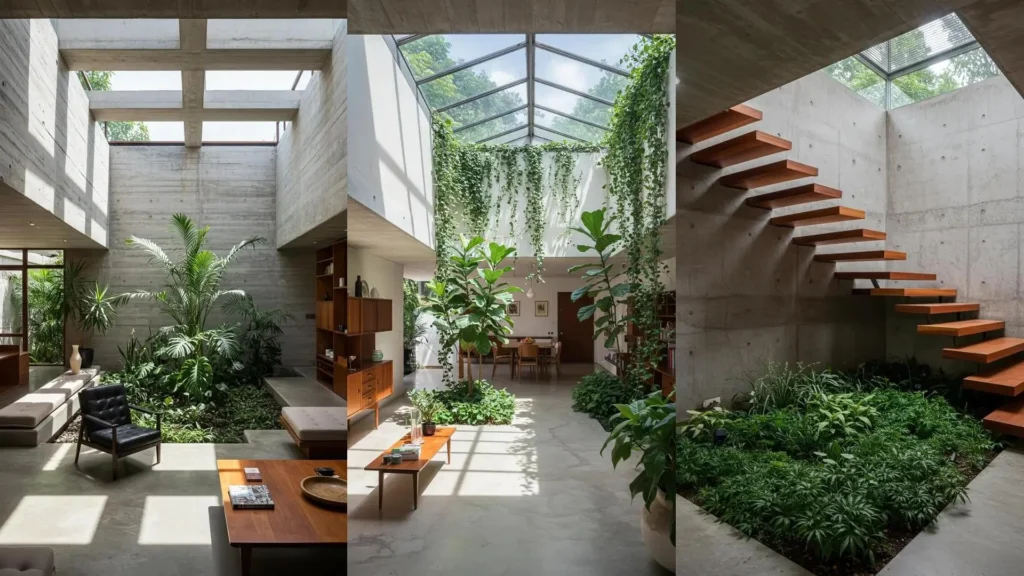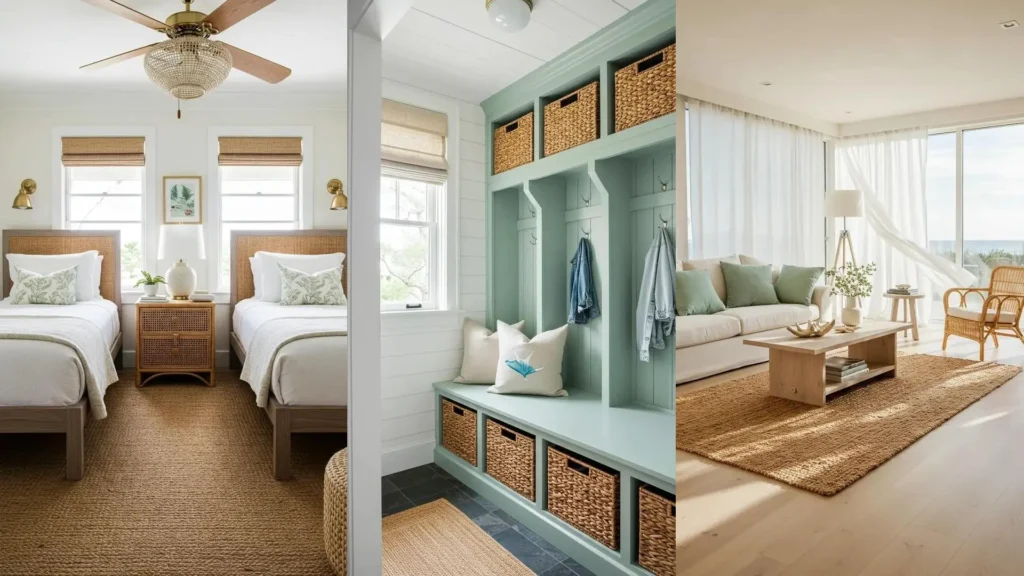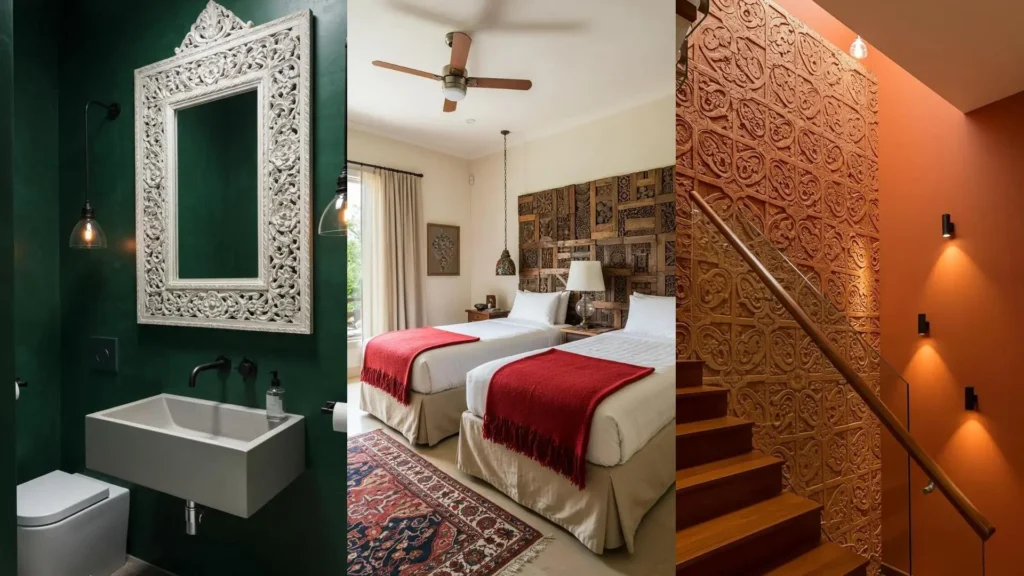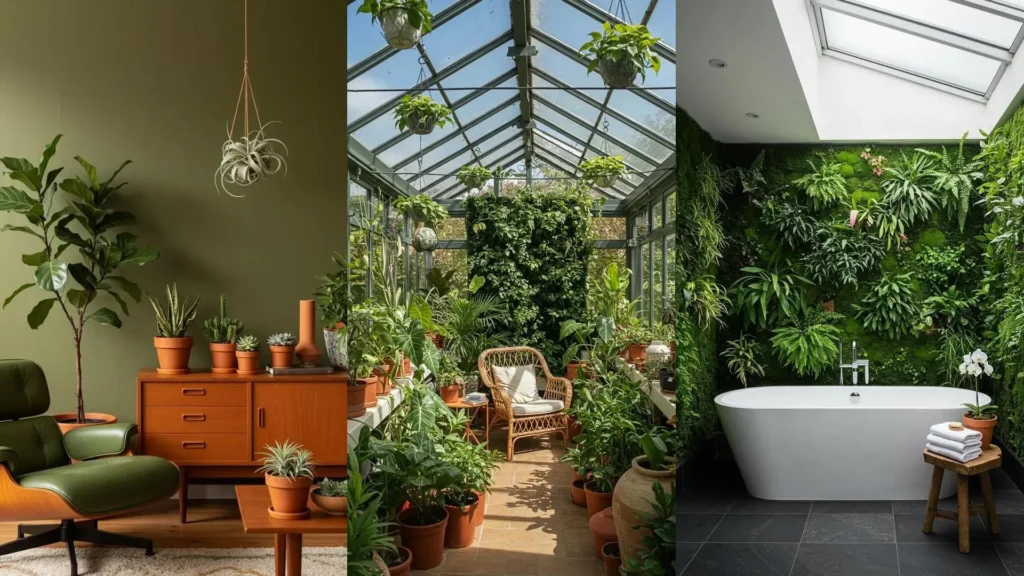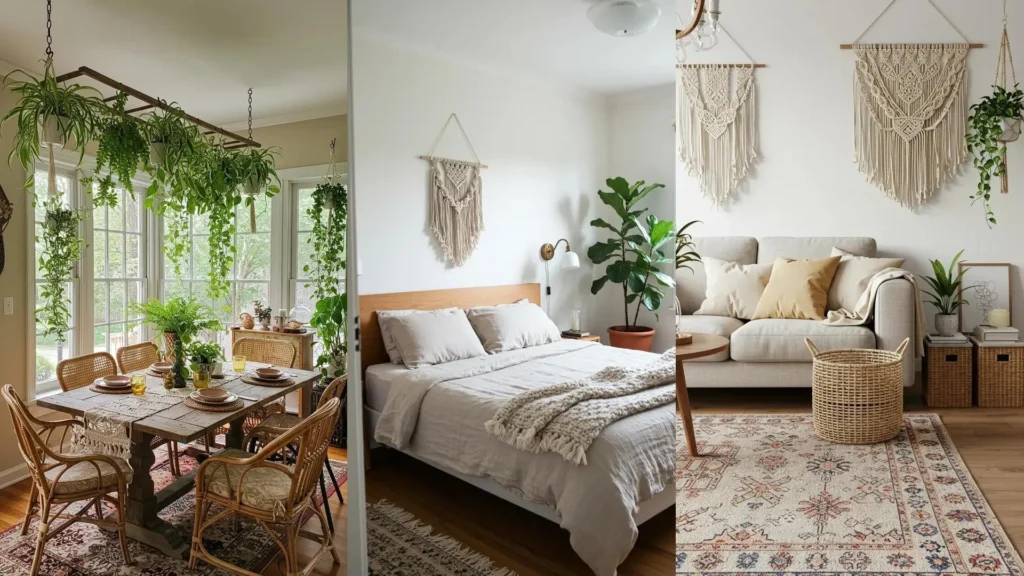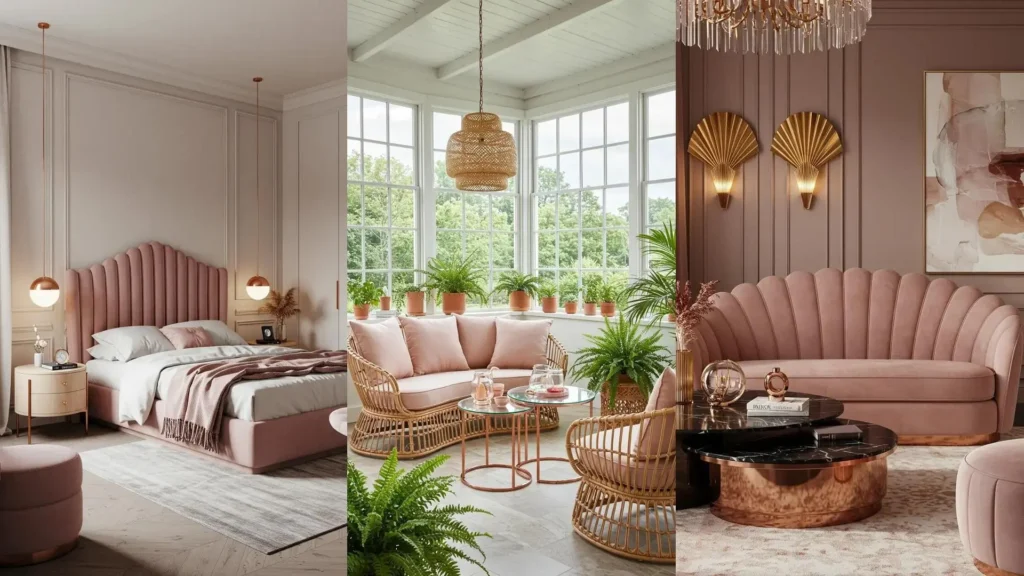There’s a unique power in Brazilian modernist design—a warmth that emanates from raw materials and a deep reverence for nature.
It’s a style that proves you don’t need ornate decoration to create a space that feels profound, personal, and deeply calming.
These homes show us how to live with intention, blurring the lines between inside and out. They invite you to look at your own space not as a collection of rooms, but as a holistic environment for living, breathing, and connecting.
Let’s explore how to bring this thoughtful, nature-infused elegance into your own home, one meaningful detail at a time.
1. Design a Living Atrium as the Heart of Your Home
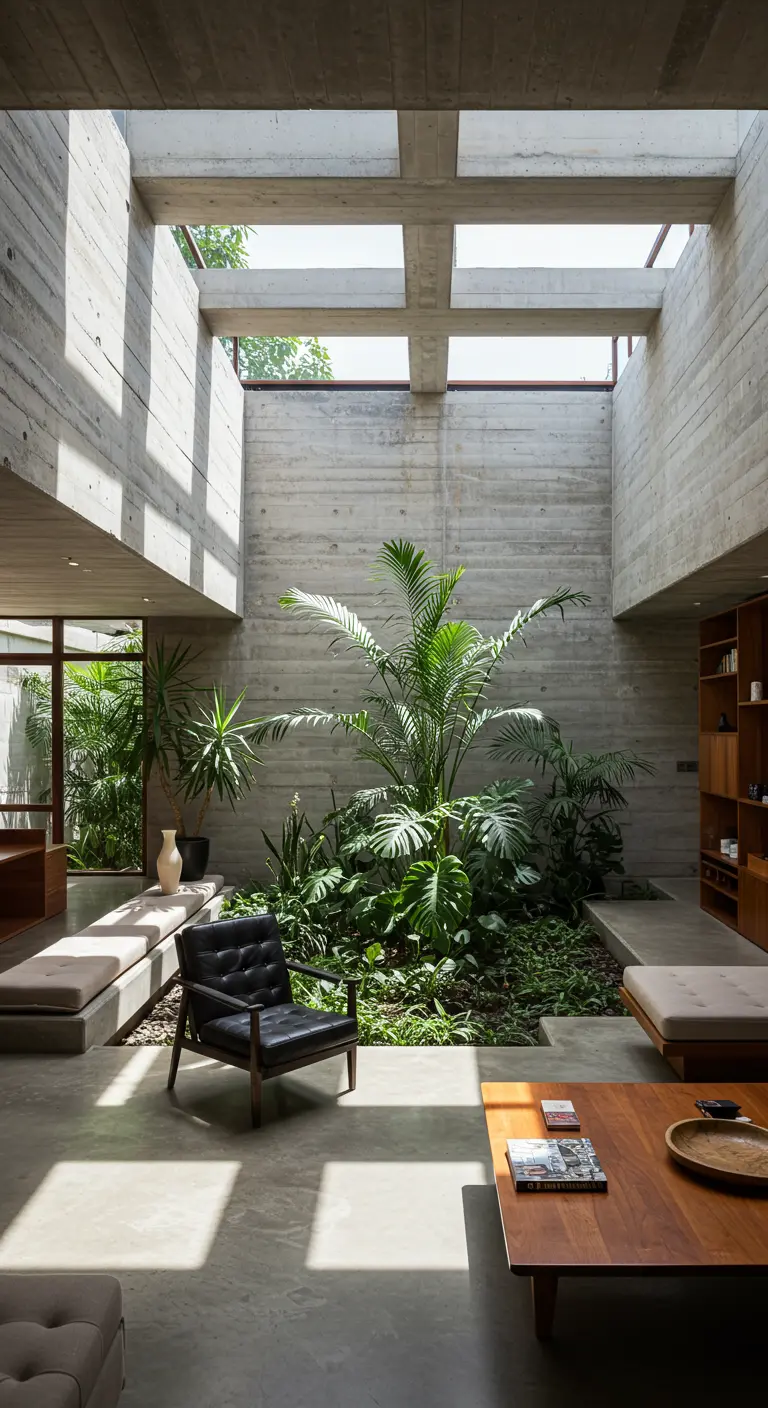
Make an indoor garden the central, organizing feature of your living space, rather than just an accessory.
Positioned under a skylight, this atrium becomes a living, breathing focal point that connects the entire room.
To achieve this without major renovation, group several large tropical plants in a corner to create a dense, jungle-like effect, or use one oversized planter as a singular statement.
The contrast between raw concrete walls and the lush, organic forms of the plants is what creates the signature modernist warmth.
2. Integrate a Functional Kitchen Herb Garden
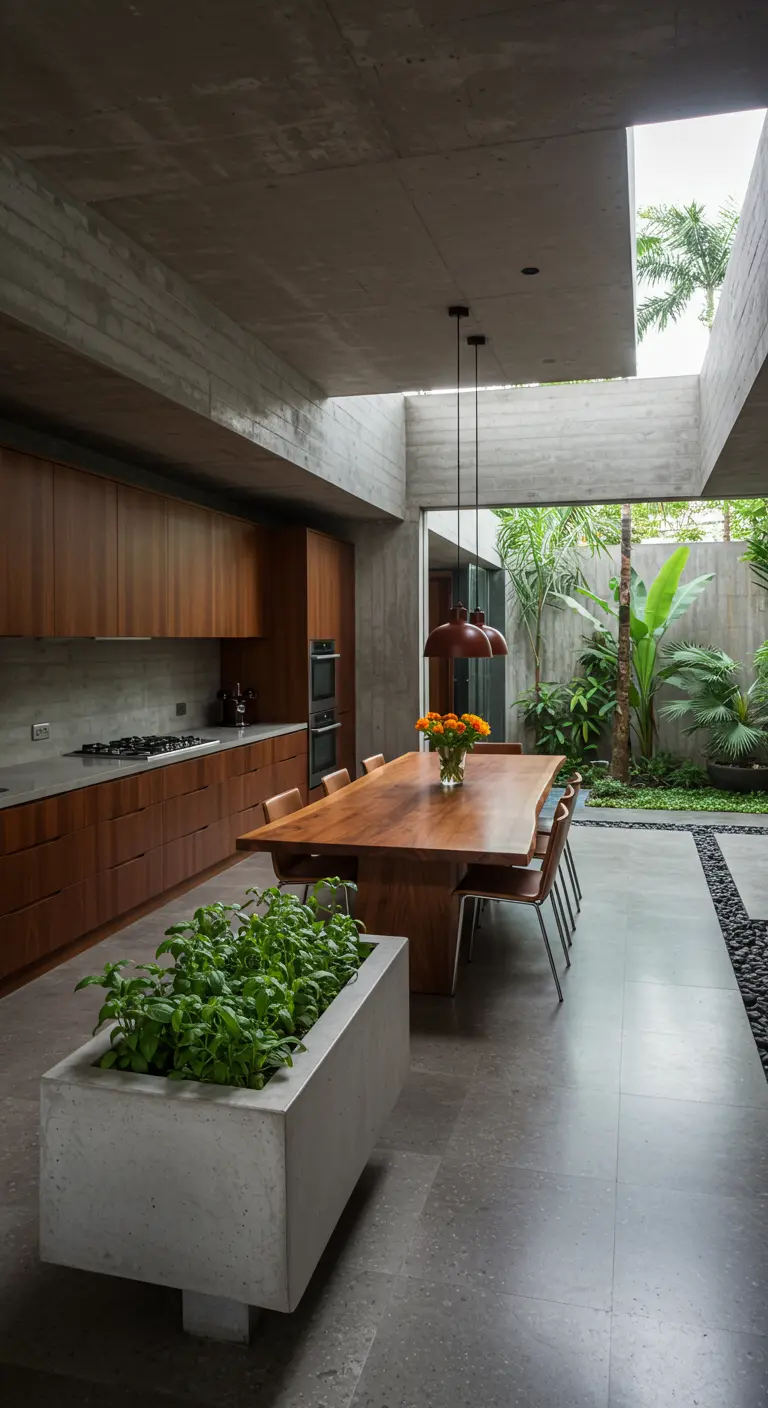
Elevate your kitchen by building in a dedicated space for fresh herbs.
This concrete planter is not only beautiful but highly practical, connecting the act of cooking directly to the source of your ingredients.
You can replicate this by commissioning a simple, trough-style planter on legs that fits the scale of your space.
For a simpler alternative, line up a series of identical terracotta or concrete pots along a windowsill or countertop for a clean, cohesive look.
3. Frame a Garden View as Living Art
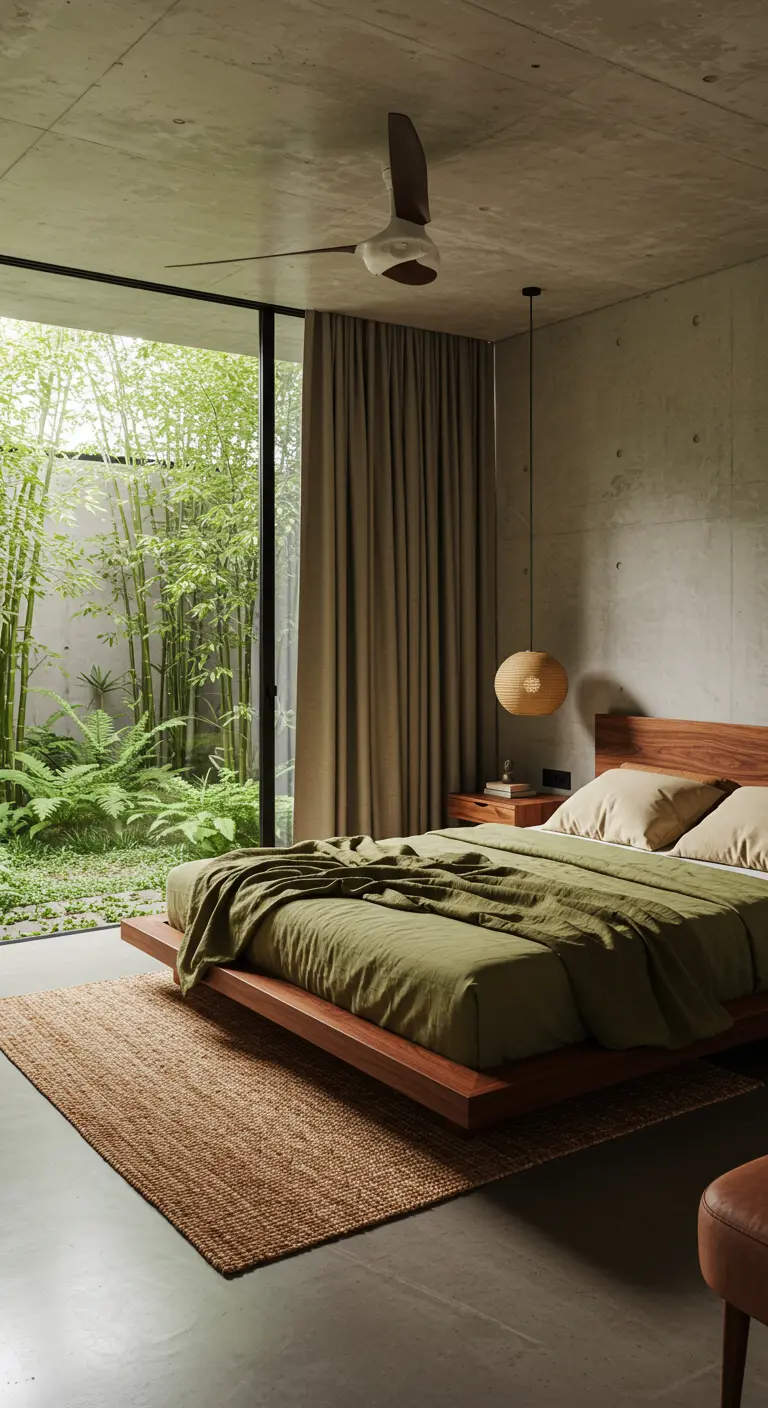
Treat a large bedroom window not just as a source of light, but as a dynamic, ever-changing piece of art.
The key is to plant a dense screen of greenery, like the bamboo seen here, which offers privacy, texture, and a serene visual backdrop.
Coordinate your interior palette—like these olive green linens—with the colors of the garden to blur the boundary between inside and out.
A low-profile platform bed ensures the view remains the undisputed focal point.
4. Soften Expansive Shelving with a Pocket Garden
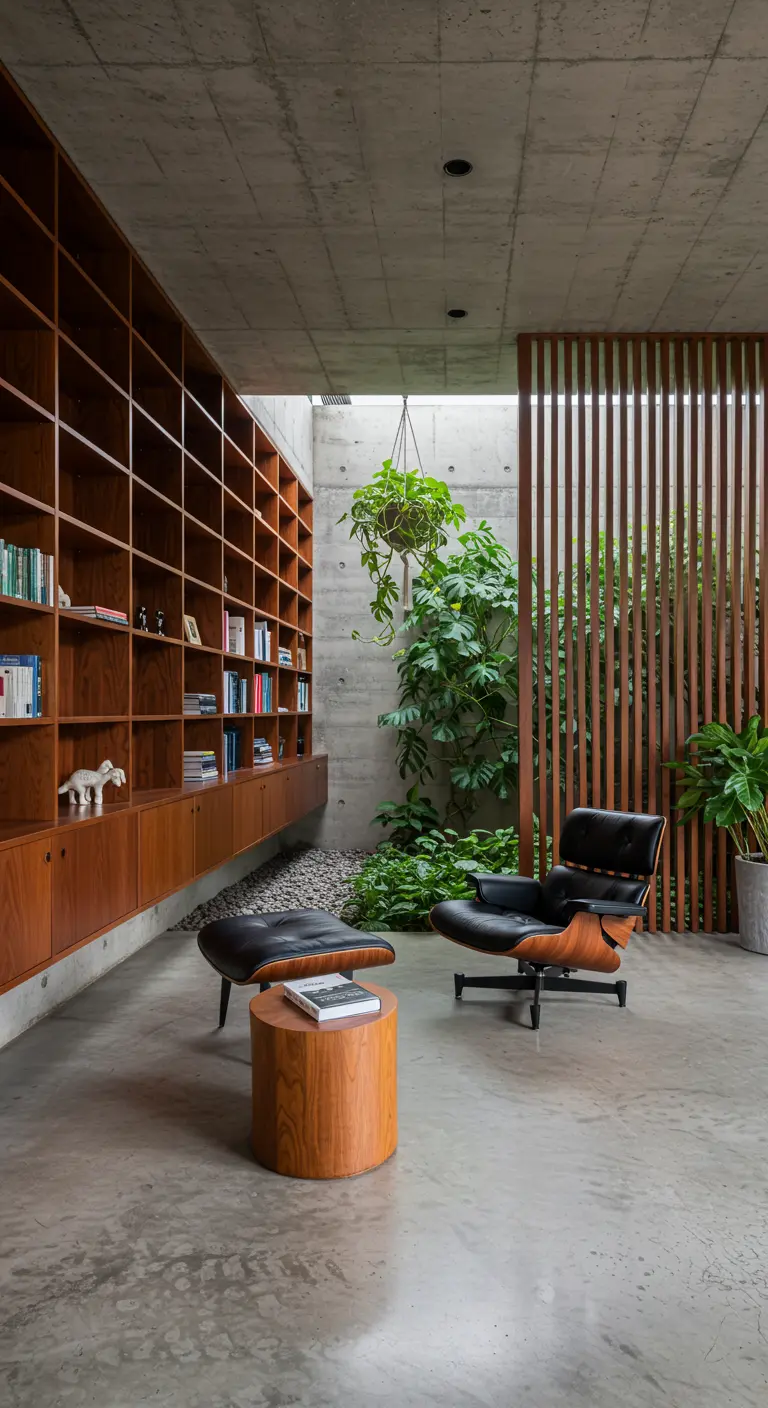
A floor-to-ceiling shelving unit provides incredible storage but can feel monolithic.
Break up the visual weight by introducing a living element, like this small, integrated garden patch.
It brings organic shape and color to an otherwise rigid structure.
To adapt this idea, simply designate one or two cubes in your existing bookshelf for a trailing plant like a pothos or philodendron to create a similar softening effect.
5. Use a Hallway to Frame a Destination
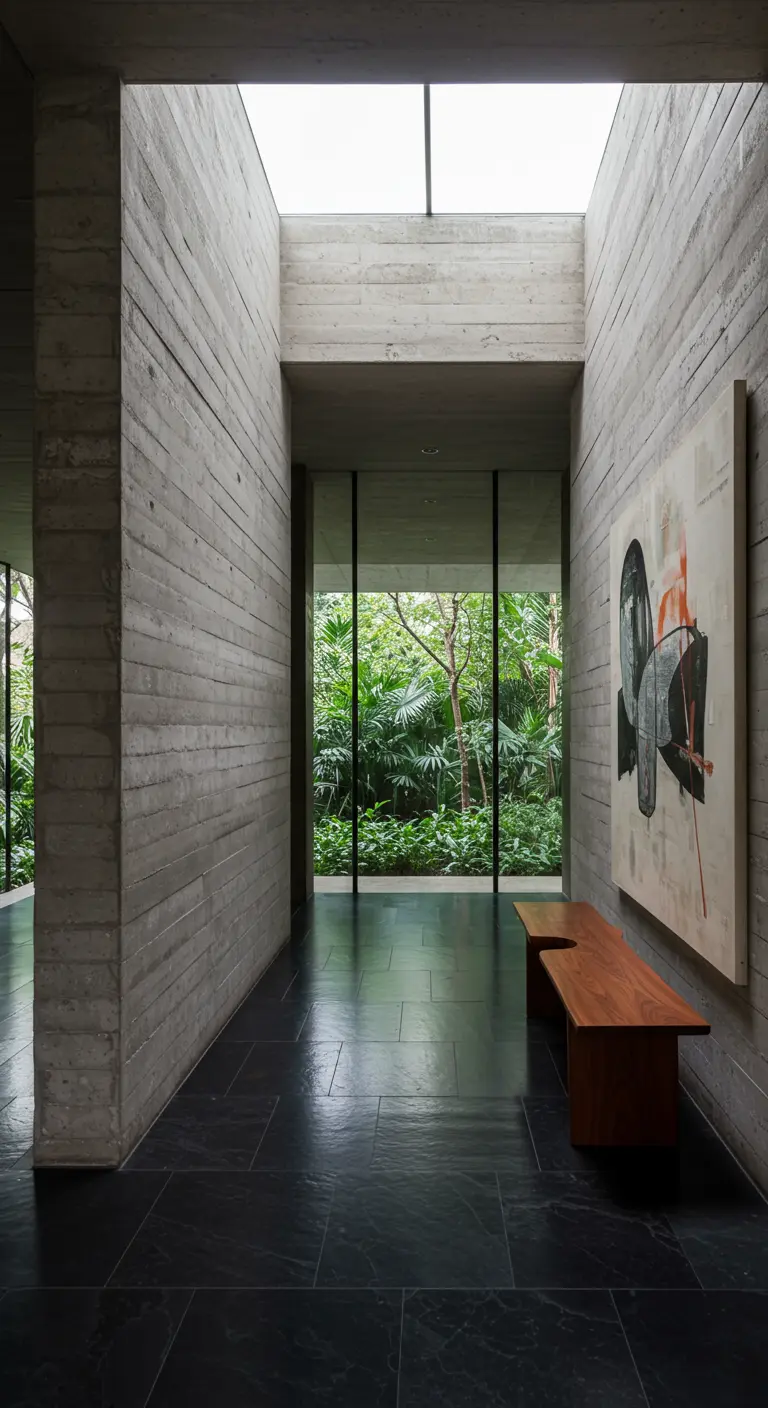
Transform a simple corridor from a passageway into a deliberate experience.
Here, dark slate floors and raw concrete walls create a compressive, gallery-like feel that directs your eye toward the bright, lush garden at the end.
This effect turns the view into a destination.
In your own home, identify a key sightline from a hallway and keep the path visually clean to emphasize the room or view beyond.
6. Create Intimacy with a Sunken Lounge
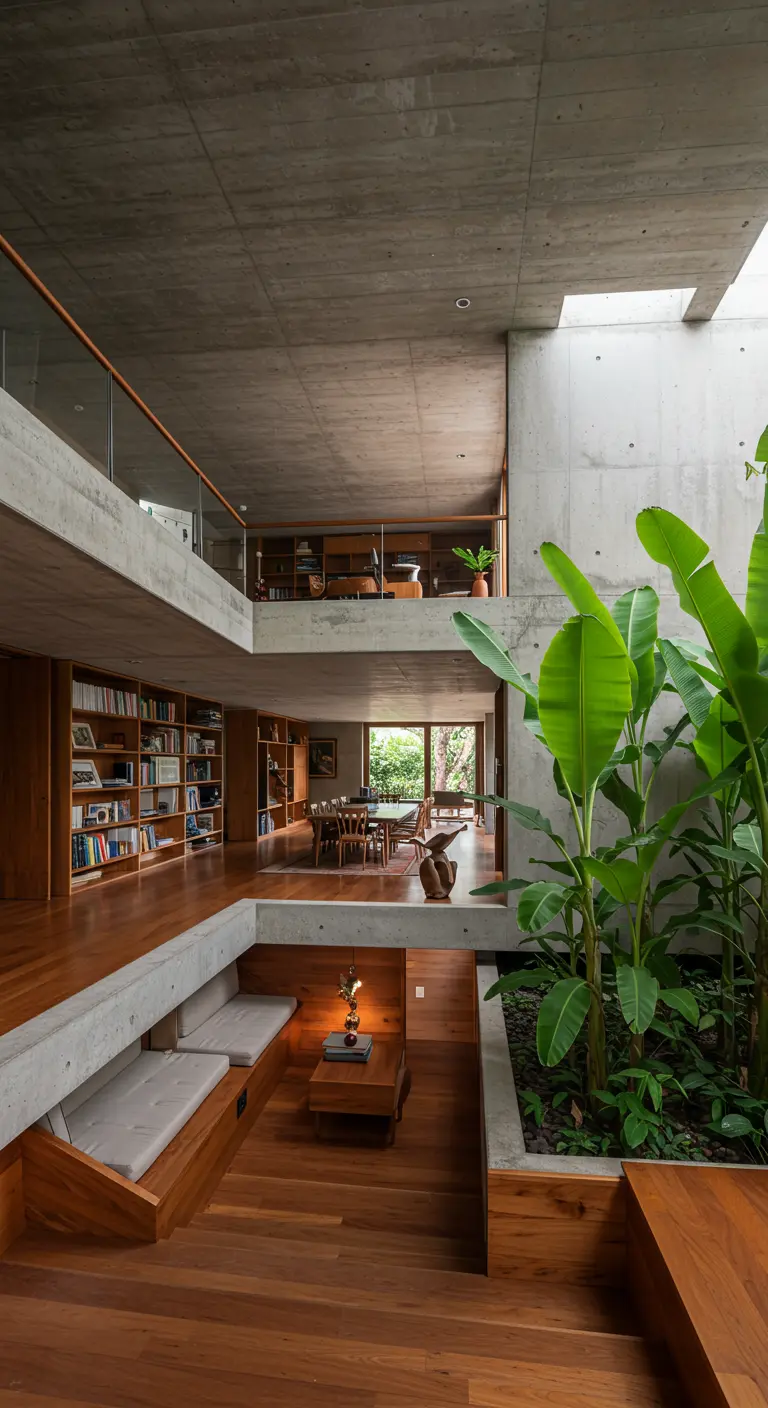
Define a distinct zone within an open-plan space by lowering the floor level.
A sunken lounge, or conversation pit, creates an immediate sense of intimacy and coziness, separating it from traffic flow without using walls.
This architectural choice naturally draws people in to gather.
For a simpler take, use a large, plush rug and low-slung furniture to create a similar grounded, room-within-a-room feeling.
7. Center Your Courtyard Around a Single Tree

Embrace biophilic design by making a mature tree the true centerpiece of an outdoor space.
The symmetry of the surrounding architecture creates a feeling of calm and reverence, turning the tree into a living sculpture.
An open roof allows it to grow naturally, truly blending the built environment with the wild.
On a smaller patio, a single, beautiful tree in a large sculptural planter can have a similar, powerful anchoring effect.
8. Pair Raw Concrete with Woven Textures
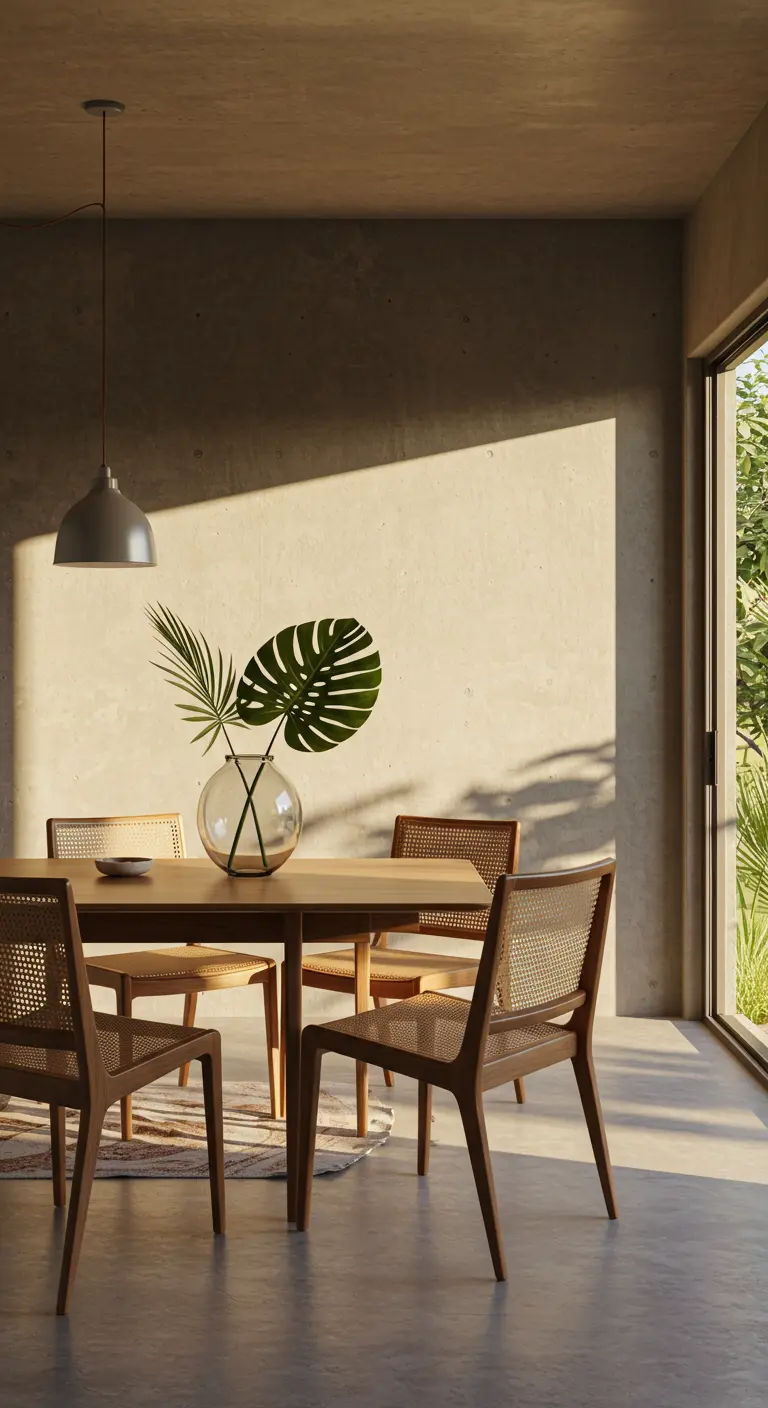
Effectively soften the industrial feel of raw concrete walls by introducing natural, woven textures.
The cane webbing on these mid-century chairs adds warmth, lightness, and a tactile quality that invites you in.
This contrast is essential for making minimalist spaces feel welcoming rather than cold.
A simple jute or sisal rug under the dining table would achieve a similar grounding, textural effect.
9. Design a Bathroom as a Private Garden Sanctuary
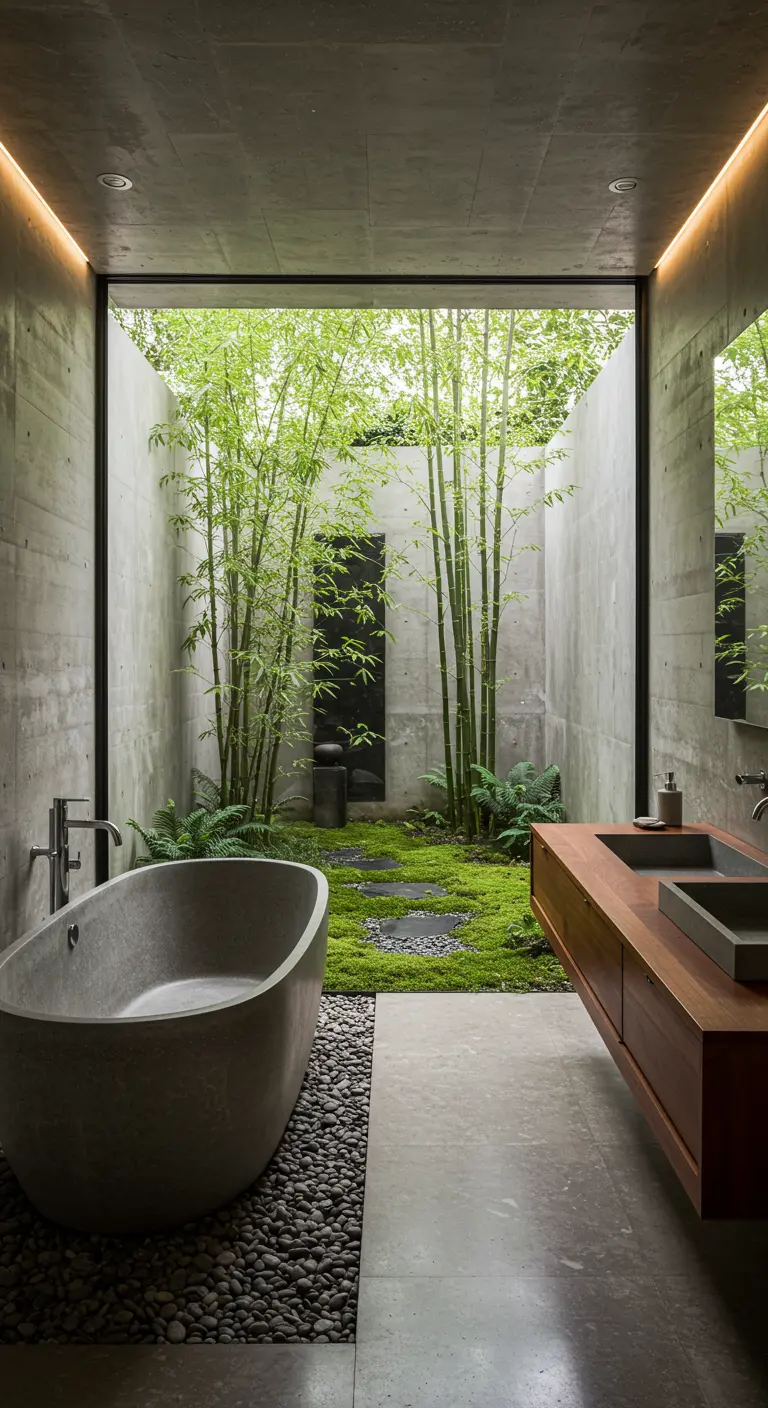
Extend your bathroom into a private courtyard to create the ultimate escape.
A floor-to-ceiling glass wall erases the boundary, making the garden an integral part of the room itself.
The use of natural materials like stone, moss, and bamboo fosters deep tranquility.
You can evoke this feeling in any bathroom by adding an abundance of humidity-loving plants, like ferns and calathea, and choosing earthy, natural materials for your accessories.
10. Anchor a Room with a Monolithic Fireplace
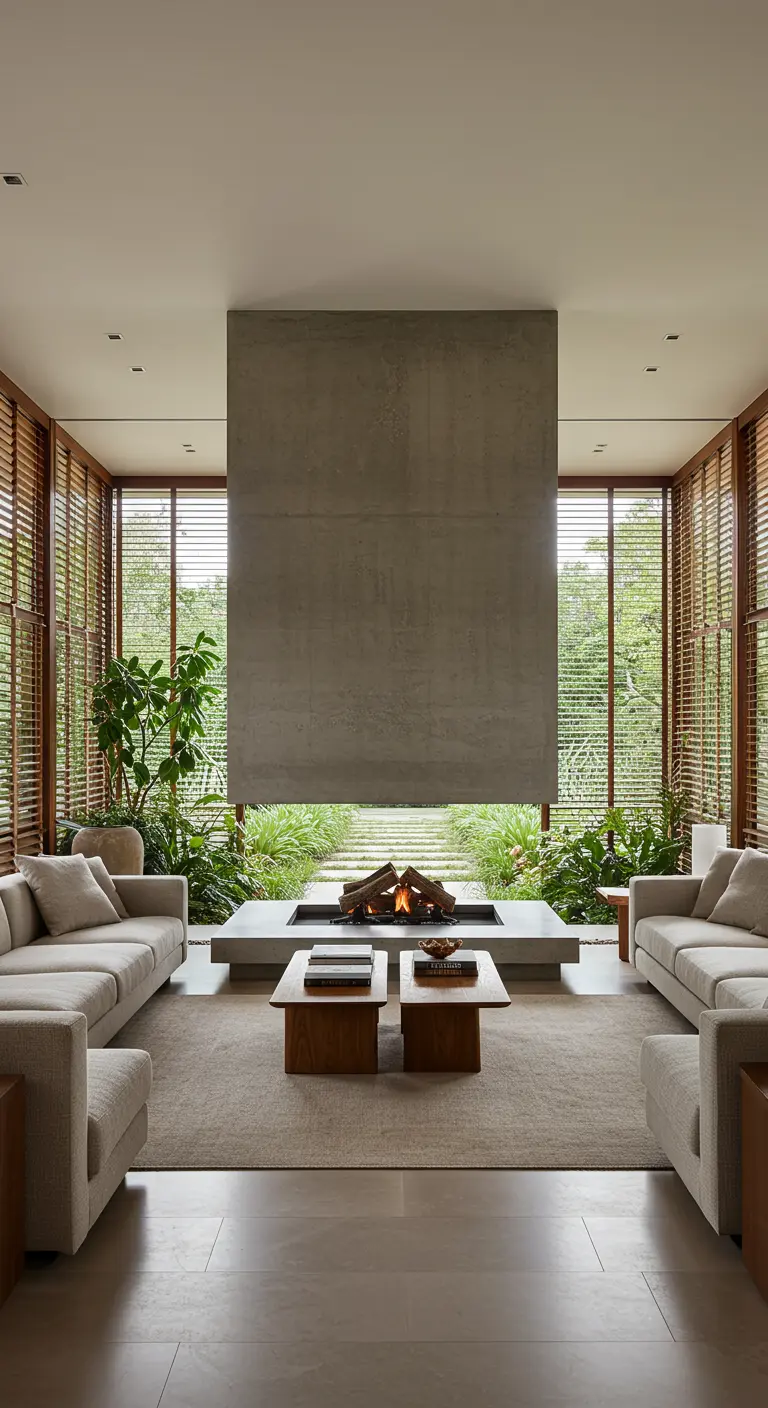
Make your fireplace a powerful architectural statement rather than a decorative afterthought.
This raw concrete form extends to the ceiling, creating a strong vertical axis for the room’s symmetrical layout.
The slatted wood blinds on either side add warmth and filter light, balancing the mass of the concrete.
In your home, tiling a fireplace wall from floor to ceiling in a single material can create a similarly dramatic and intentional effect.
11. Float a Staircase Over an Indoor Garden
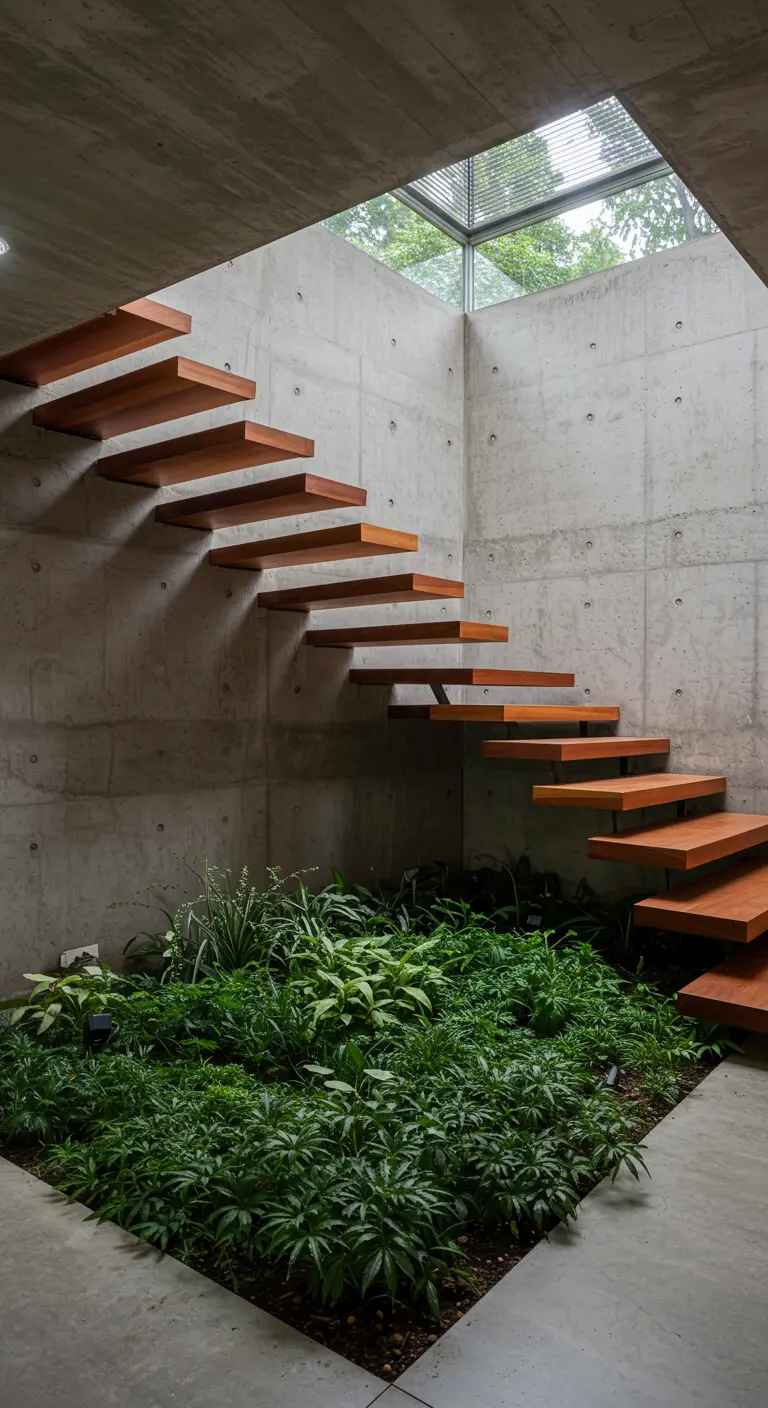
Turn a purely functional element into a stunning work of art.
A floating staircase already feels light and sculptural, but placing it over a bed of lush greenery transforms the experience of moving through the space.
The warmth of the wood treads against the cool concrete is perfectly mediated by the vibrant, living plants below.
Consider how strategic lighting from a skylight or hidden LEDs could further accentuate this feature.
12. Define a Nook with a Textured Stone Wall
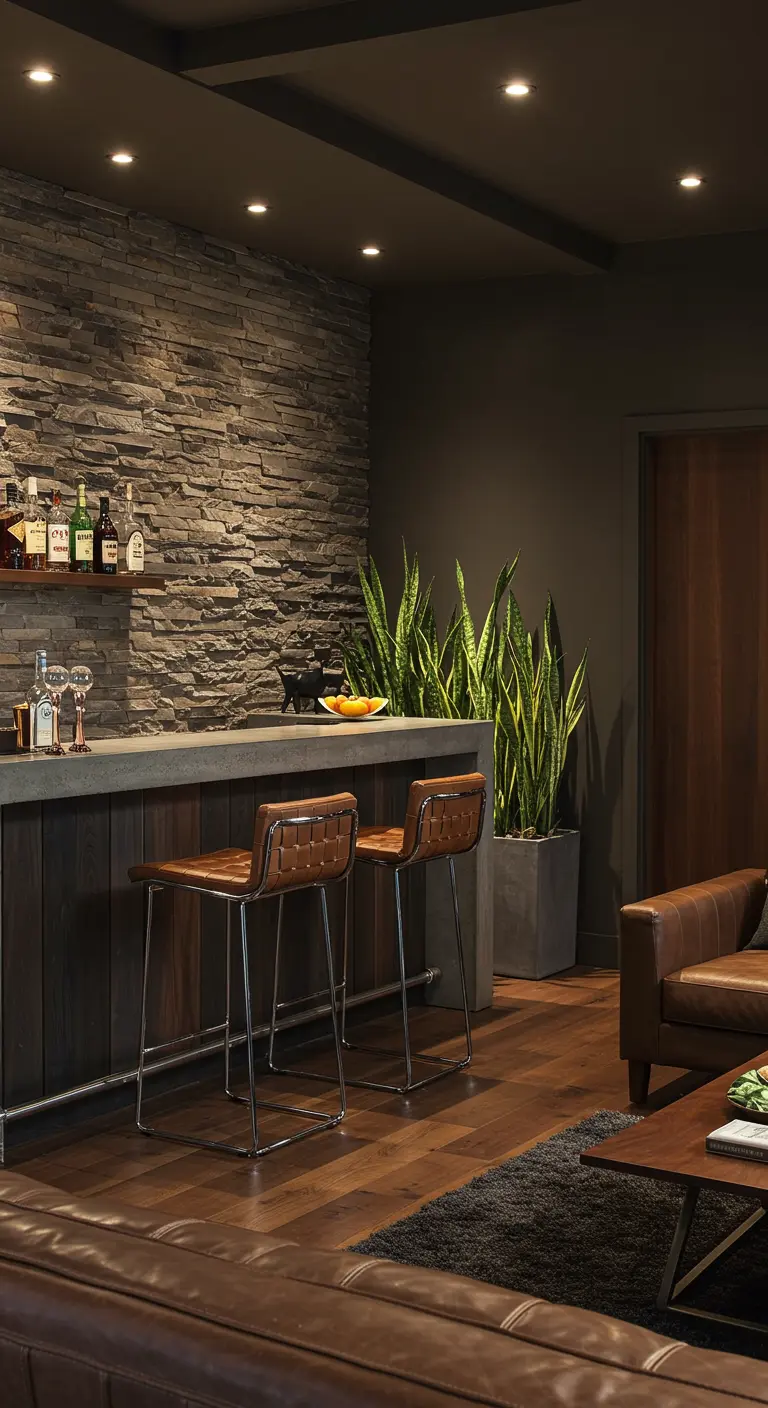
Add rugged sophistication to a home bar or reading nook with a stacked stone accent wall.
It provides an earthy, textural backdrop that contrasts beautifully with smoother materials like the concrete countertop and leather stools.
The tall, sculptural snake plant adds a living element that softens the hard surfaces and reinforces the natural material palette.
13. Cultivate an Immersive “Glasshouse” Room
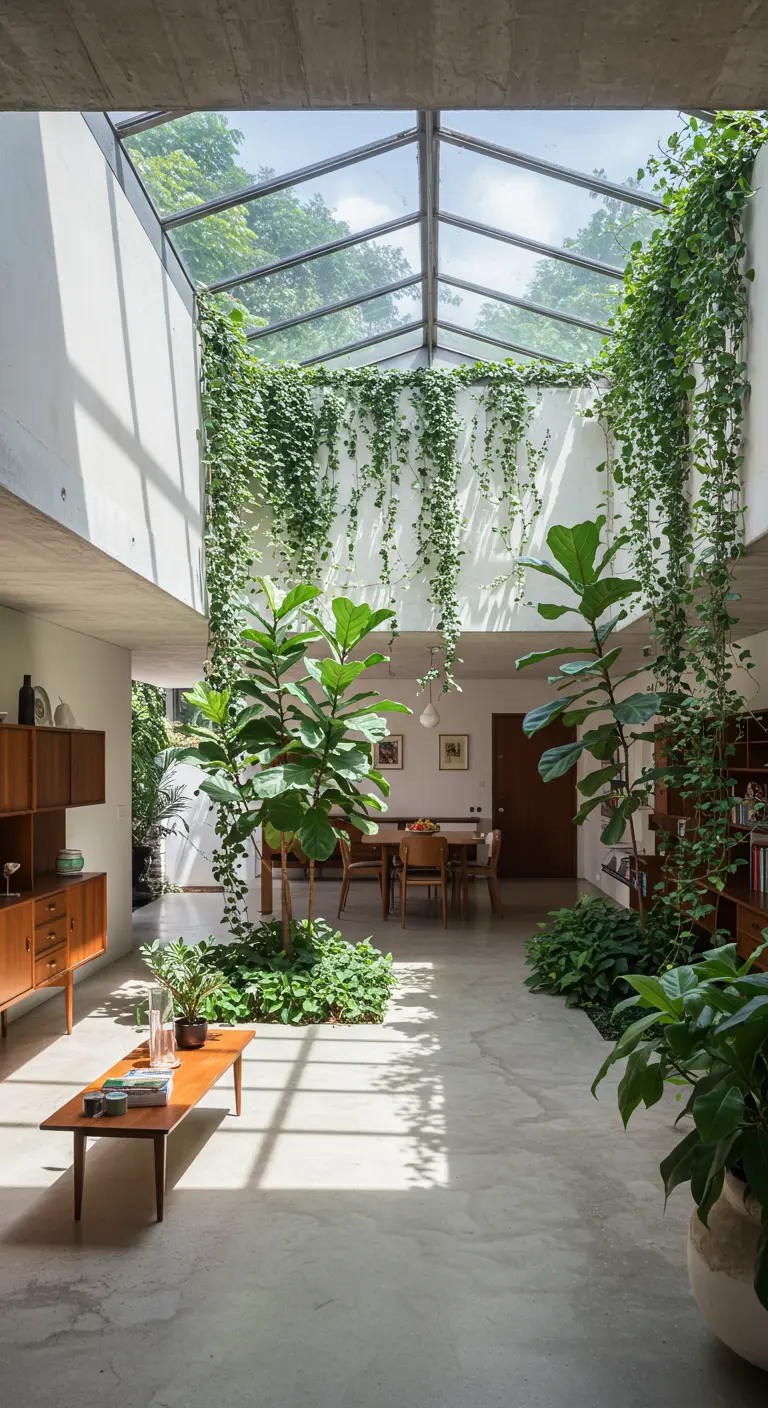
If you have a space with significant natural light from a skylight or sunroom, embrace the greenhouse aesthetic fully.
Treat the walls as a trellis for climbing plants and fill the floor with a variety of statement floor plants to create an immersive, conservatory-like feel.
Keep furniture lines clean and materials simple to ensure the lush greenery remains the undisputed star of the space.
14. Add Warmth and Texture with a Wood Slat Wall
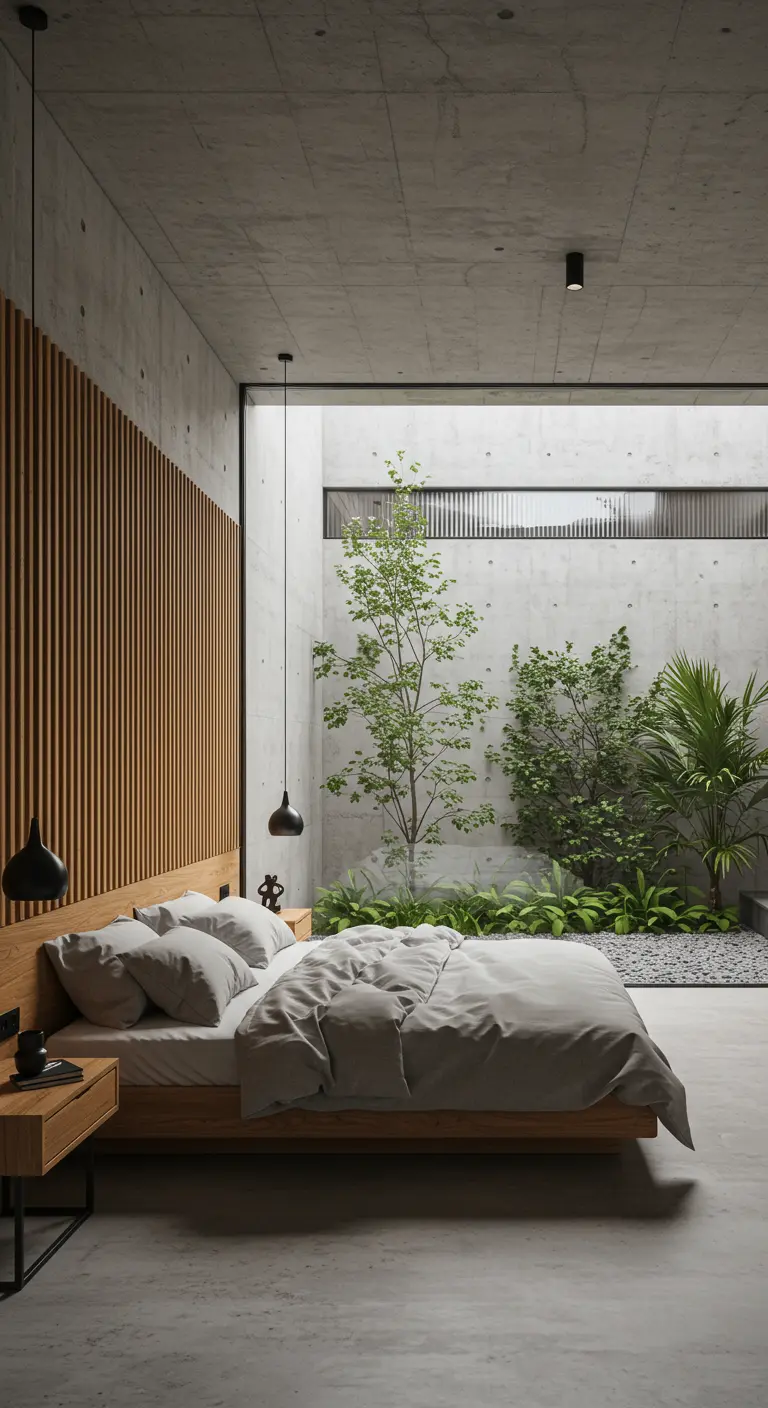
Instantly elevate a minimalist bedroom with a slatted wood feature wall.
It serves as an integrated headboard, adding warmth, rhythm, and architectural interest that balances the coolness of concrete walls.
The strong vertical lines also draw the eye upward, creating a sense of height.
This is a powerful, high-impact update that can serve as the only decor a wall needs, much like in Japanese-inspired interiors.
15. Style Shelves with Form and Patina
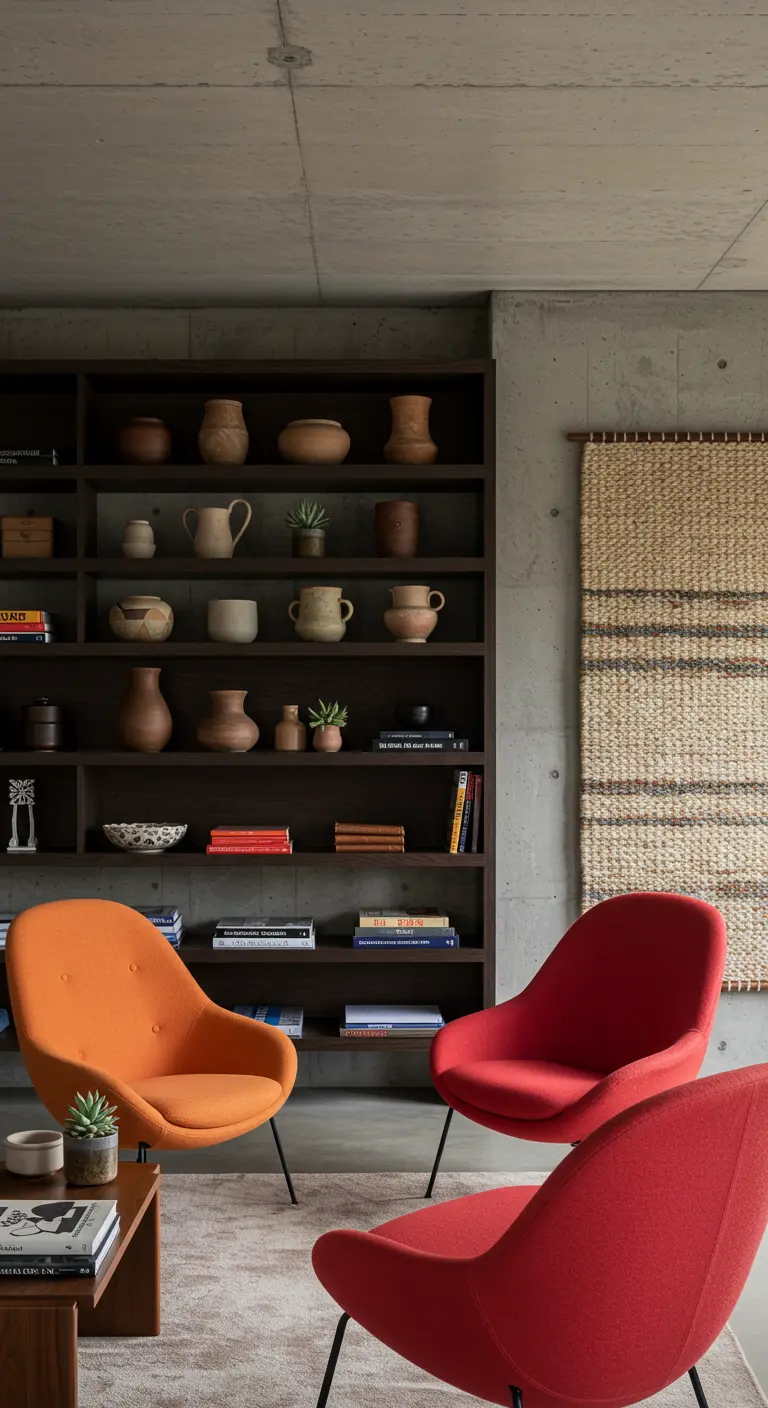
Treat your bookshelves as a curated exhibition of personal objects, not just a place for books.
Intersperse reading material with collections of handmade pottery or sculptures, creating small, artful vignettes.
Group items by texture and earthy tones to build a cohesive narrative, as seen with these ceramics that echo the woven wall hanging.
This approach turns simple storage into a rich, eclectic display.
16. Grow a Living Wall for Ultimate Visual Impact
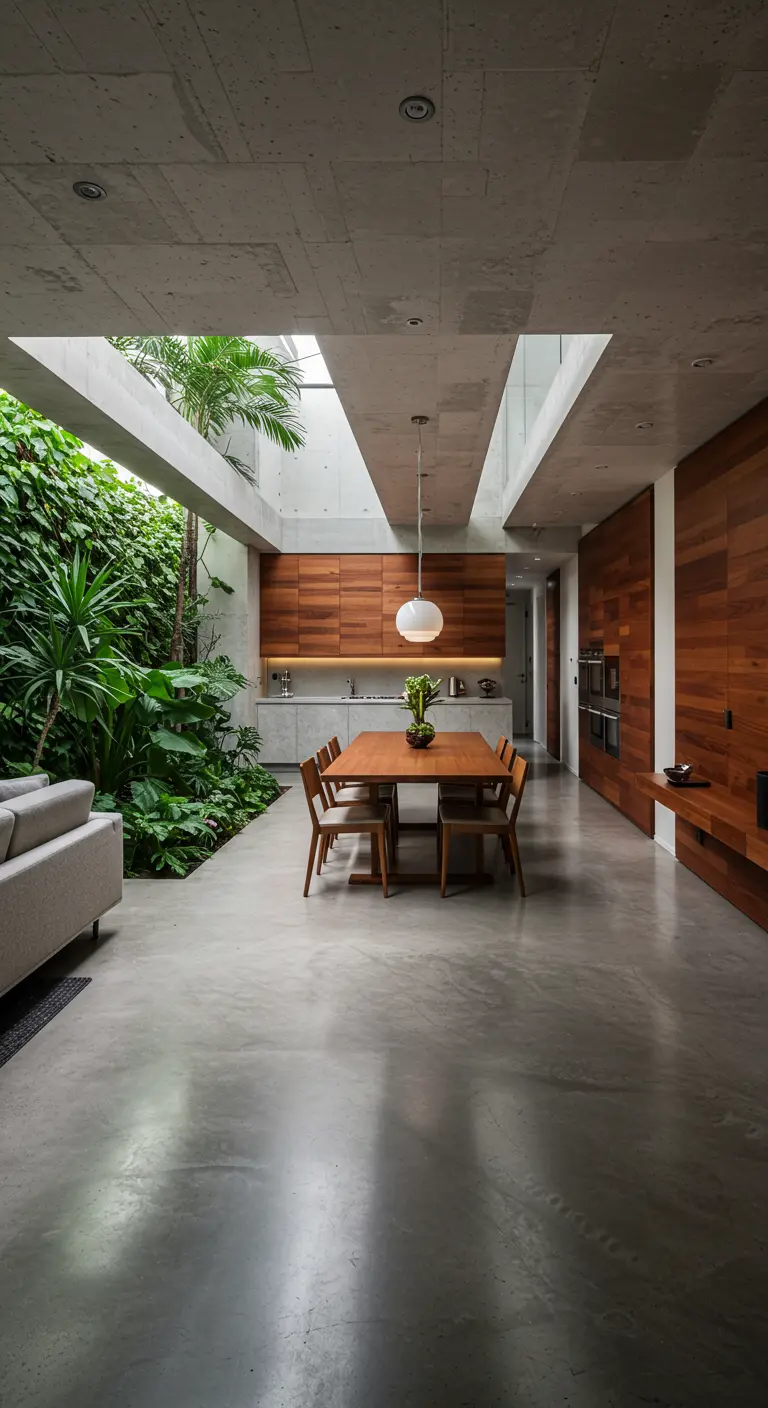
For a truly breathtaking statement, dedicate an entire wall to greenery.
A living wall acts as dynamic, natural art, purifies the air, and provides unparalleled texture, completely blurring the line between inside and out.
If a fully integrated system is out of reach, you can achieve a similar effect with grid panels or a trellis that encourages climbing plants to cover the surface.
17. Master Landscape Lighting for Evening Ambiance
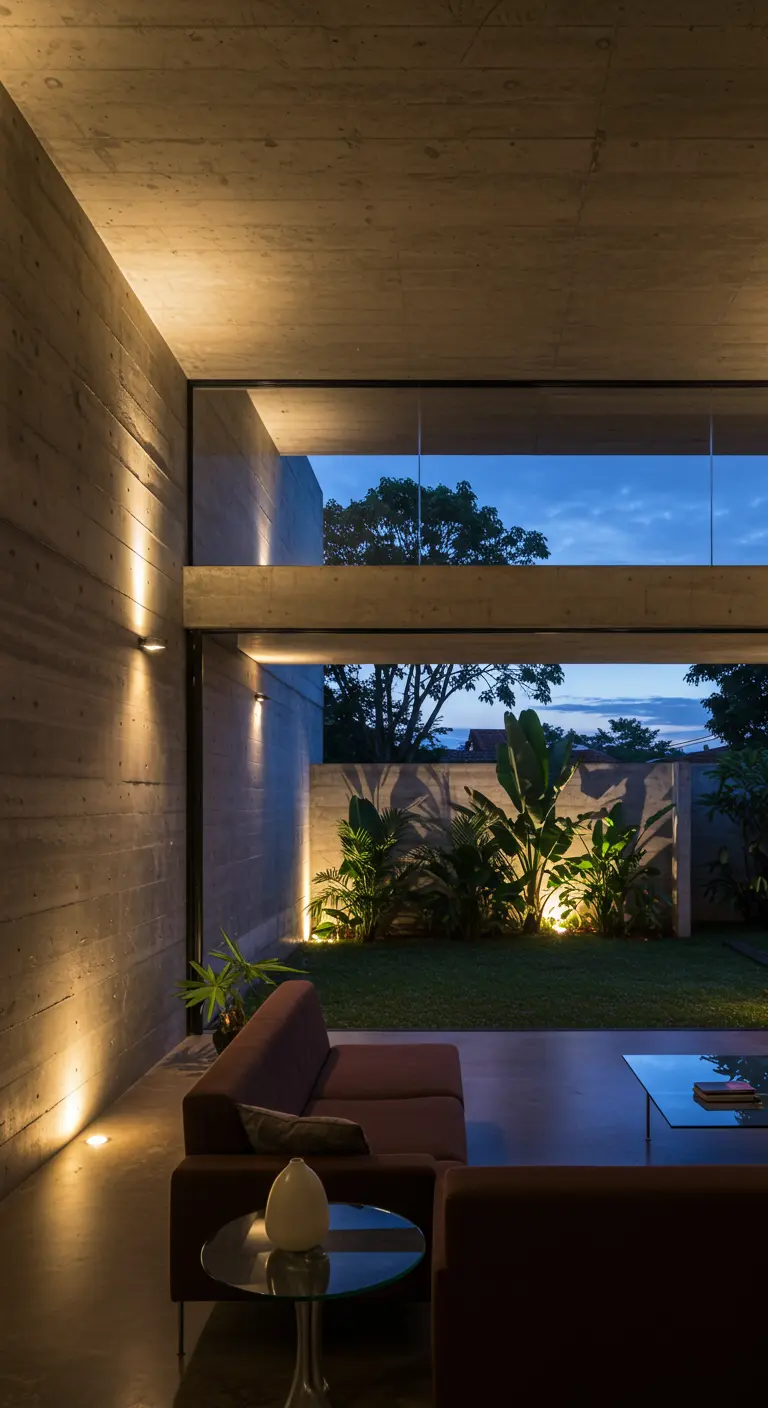
Your garden’s beauty shouldn’t disappear when the sun goes down.
Use strategic uplighting to highlight the sculptural forms of trees and foliage, creating dramatic shadows and a deep sense of dimension.
This simple technique transforms your windows into captivating, living artworks every evening.
To enhance the effect, keep your interior lighting soft and low to minimize reflections on the glass.
18. Carve Out a Focused, Minimalist Workspace

Create a dedicated workspace that feels fully integrated and intentional, not like a temporary setup.
Here, a simple niche is transformed into a clean, focused office with a built-in wooden desk and drawer.
This approach maintains an uncluttered feel, requiring only a sculptural plant and a classic task lamp to be complete.
It’s an ideal solution for combining work and living areas seamlessly.
19. Design a Sanctuary-Like Conversation Pit
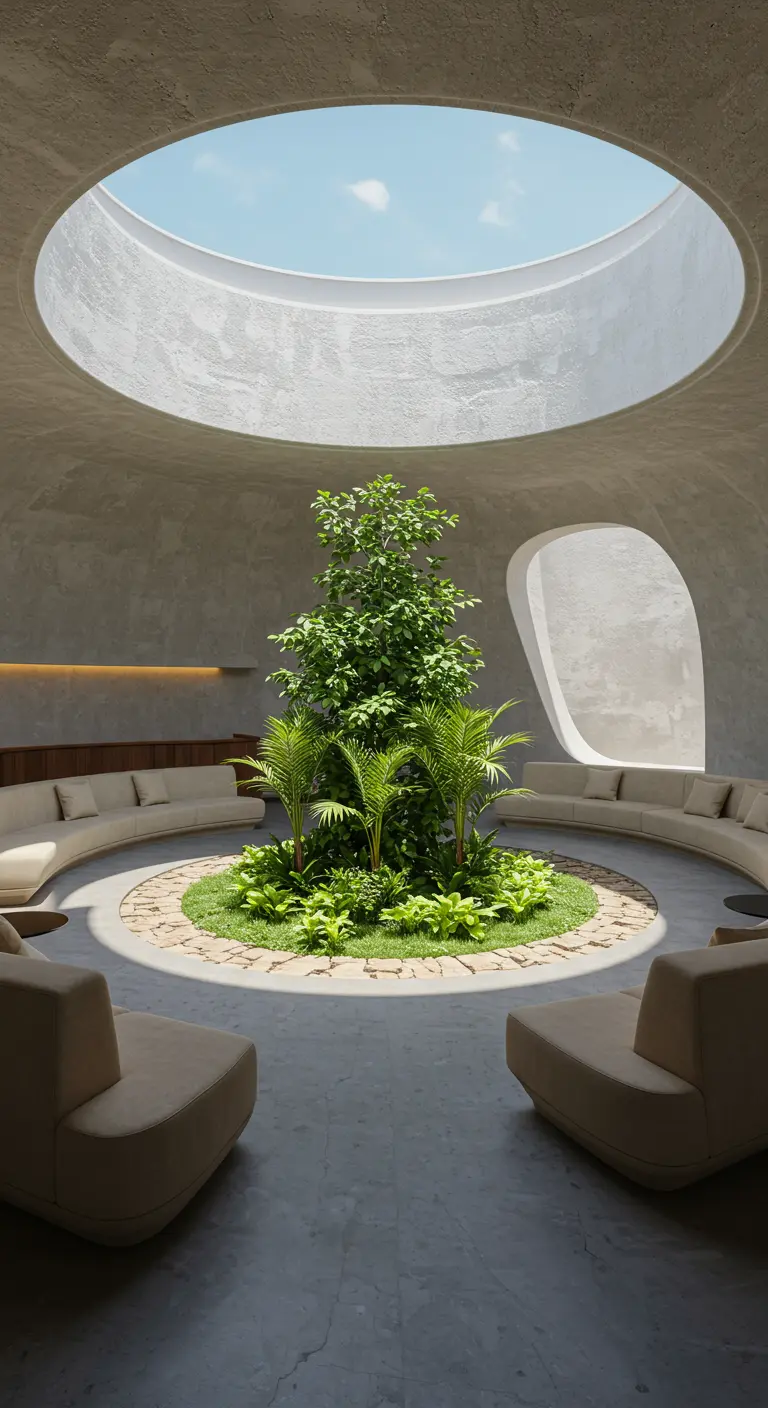
This is the ultimate expression of communal, nature-focused architecture.
A circular, sunken seating area inherently fosters connection and conversation, while the central tree under a dramatic oculus connects the inhabitants to the sky.
You can recreate this feeling of sanctuary without construction by arranging your sofas and chairs in a tight, circular formation around a large coffee table.
20. Use Sculptural Plants in a Media Room
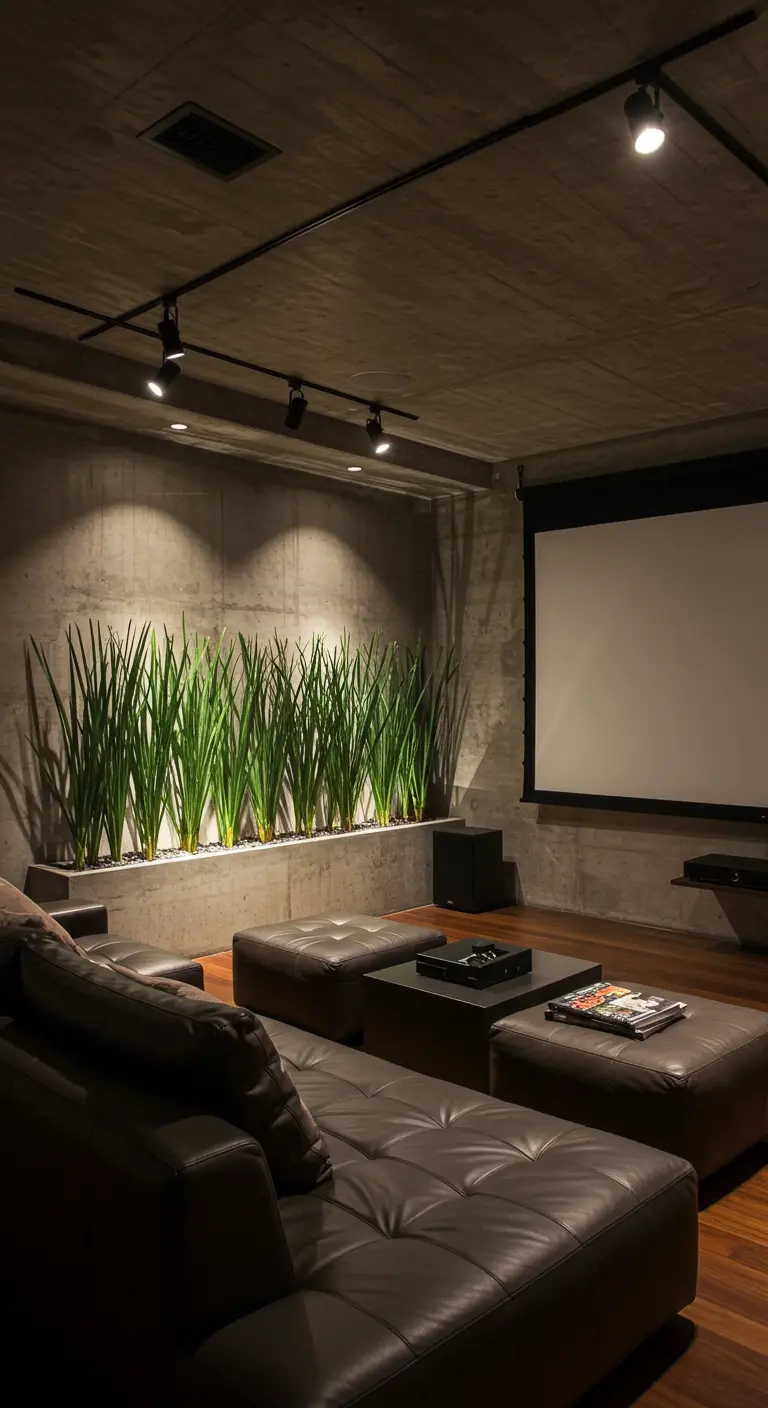
Media rooms can often feel dark and sterile due to the focus on technology.
Introduce a row of resilient, low-light plants like snake plants to add a living, sculptural element.
Here, they are set in a sleek built-in planter and highlighted with track lighting, turning them into a design feature that also helps improve air quality.
Their clean, vertical lines soften the space without creating a visual distraction from the screen.
21. Create an “Al Fresco Room” Surrounded by Nature
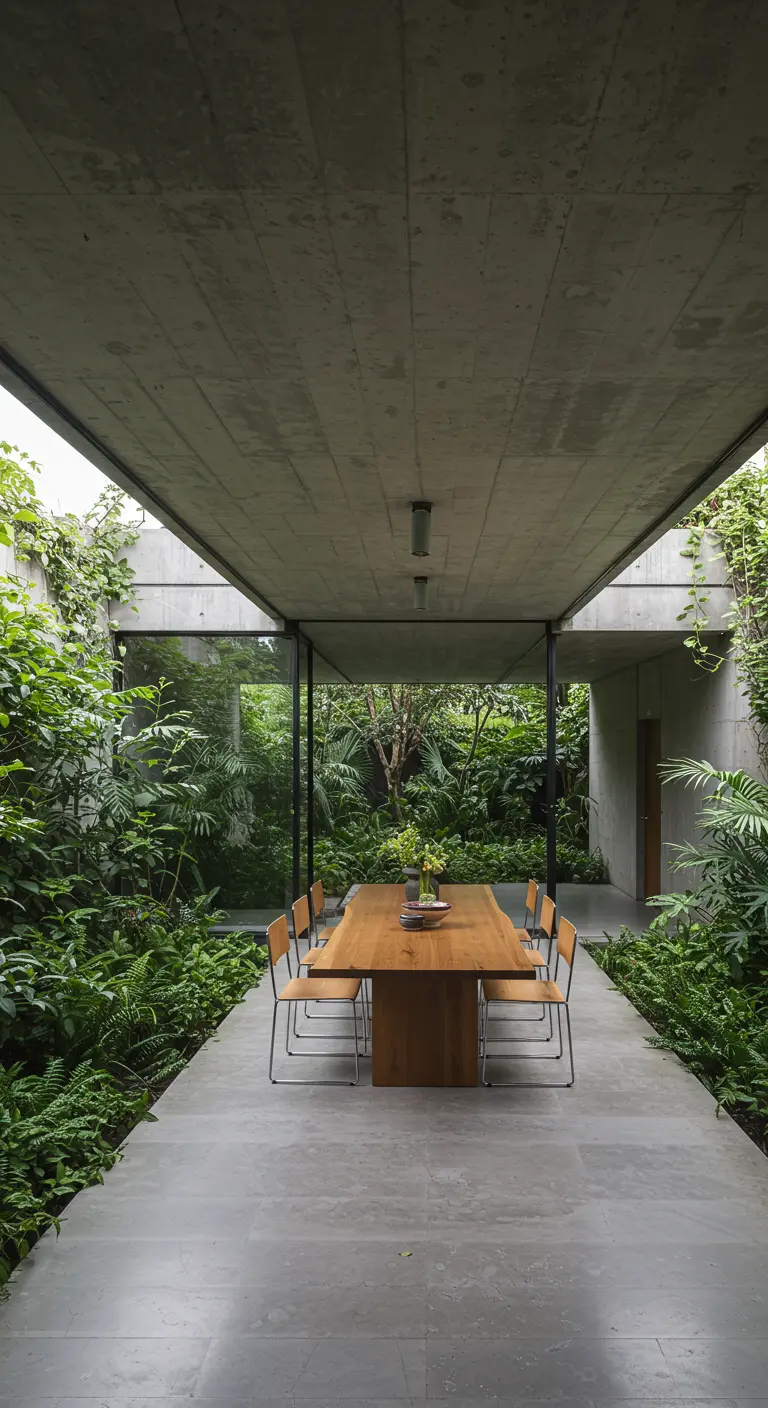
Dissolve the barrier between your dining room and the garden by creating a true outdoor room.
This covered patio is protected from the elements but feels completely immersed in the dense, lush foliage.
The simple concrete structure allows the vibrant greenery to be the main feature.
Recreate this feeling on a porch by using outdoor curtains and surrounding the space with an abundance of potted plants and lanterns.
22. Achieve Serenity with a Floating Platform Bed
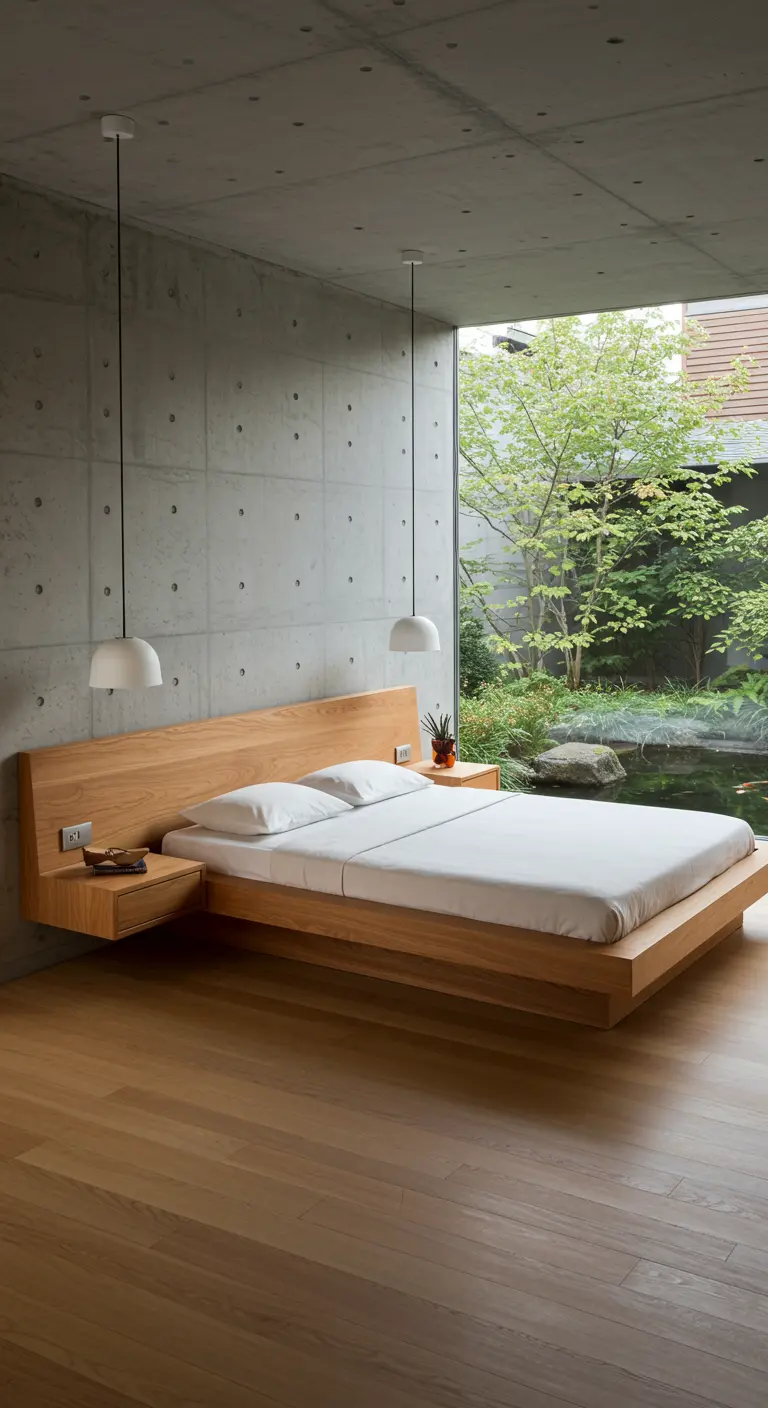
A floating bed frame creates an airy, uncluttered feeling, making a room feel more spacious and serene.
The recessed base makes the platform seem to hover, lending a light, almost weightless quality to a solid piece of furniture.
Paired with integrated floating nightstands, it’s the epitome of clean, Japandi-style design.
23. Anchor a Neutral Room with Bold Art and Color
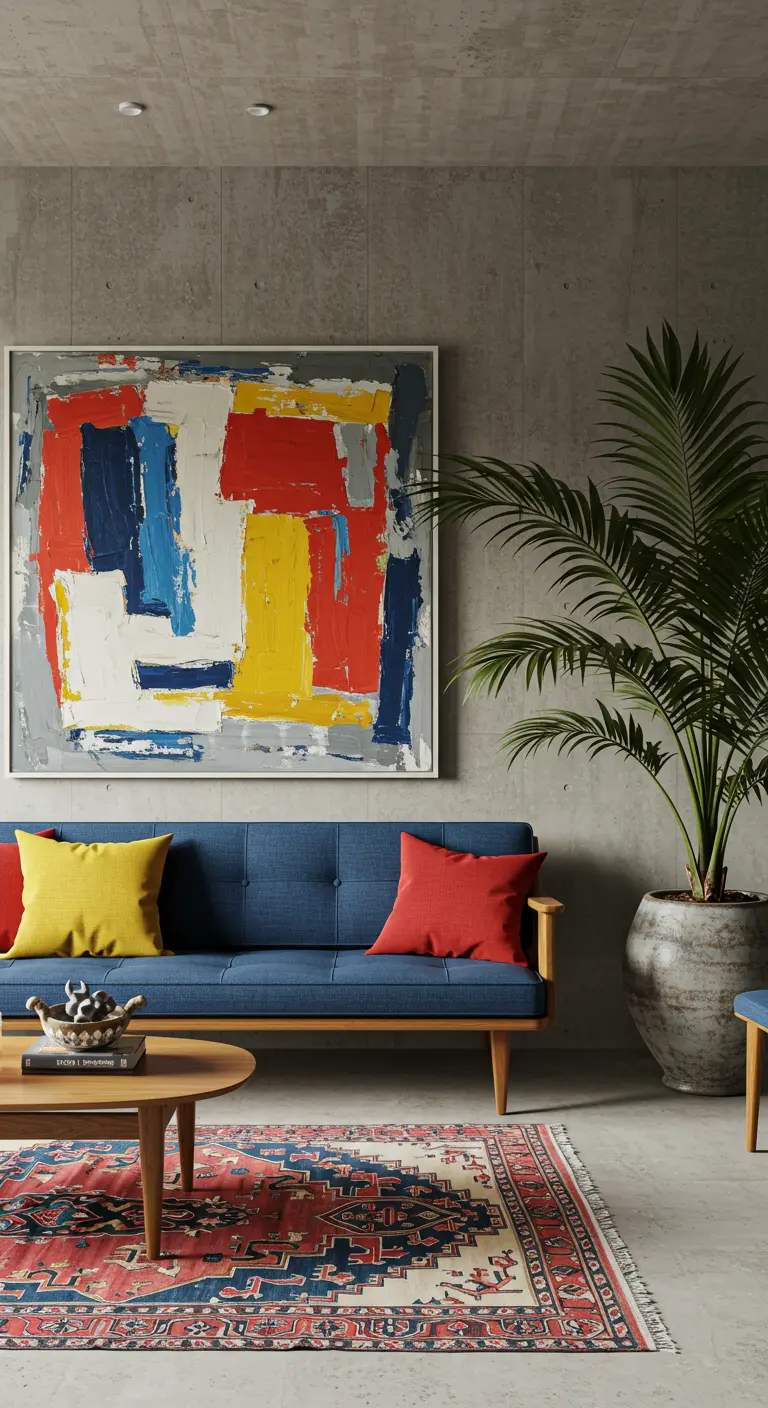
In a room with raw, neutral foundations like concrete and wood, use a large, vibrant piece of abstract art as your color anchor.
Pull primary hues from the artwork to inform your choice of textiles, like the red and yellow cushions on the sofa.
A patterned rug adds another layer of texture and grounds the seating area, complementing the mid-century furniture without competing with the art.
24. Compose a Meditative Zen Garden View
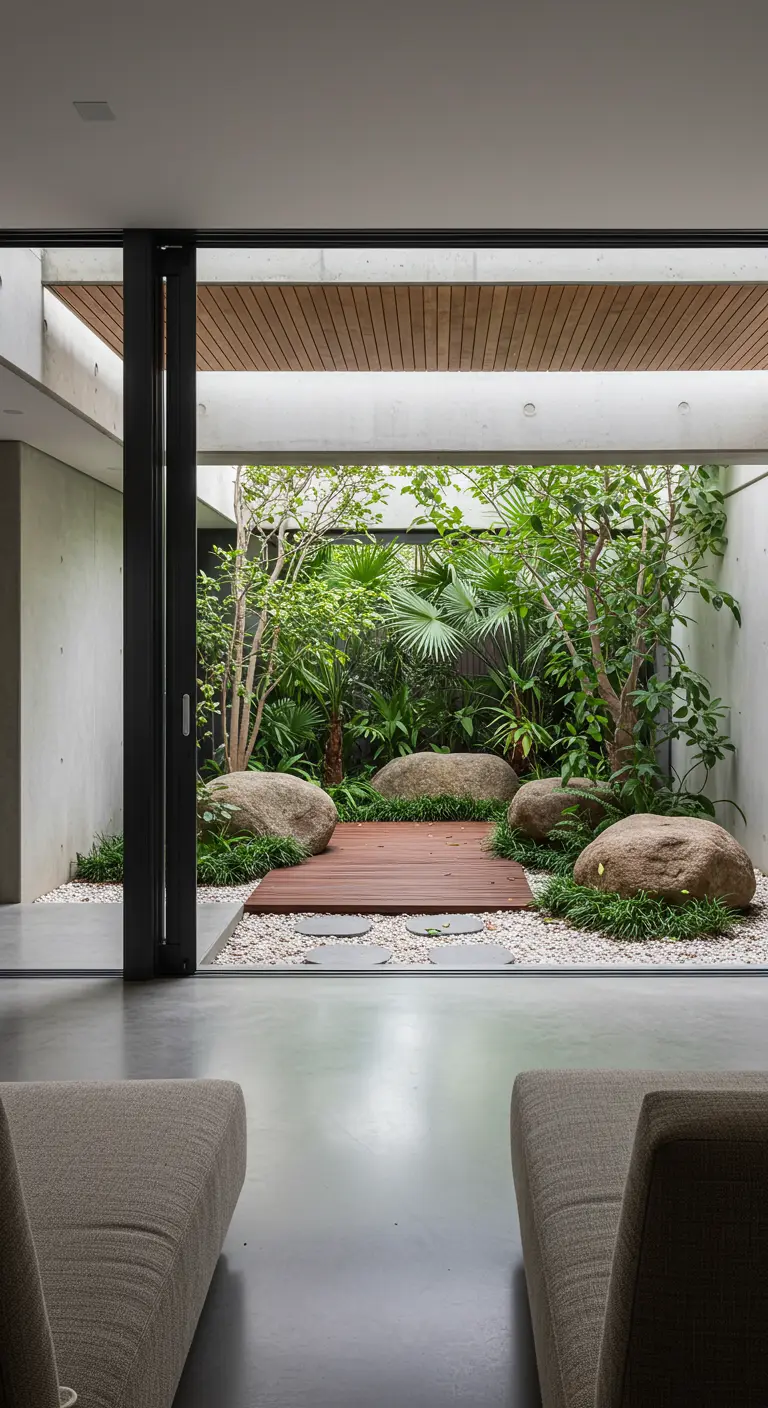
Create a tranquil, calming view by designing a minimalist courtyard garden.
Use a spare, intentional palette of materials: pale gravel, a simple wooden walkway, large natural boulders, and carefully placed greenery.
The art is in the composition—this isn’t about filling a space, but arranging each element to create a sense of profound peace and balance.
Think of it as a living sculpture to be viewed, similar to the principles behind a Zen garden.
25. Transform Your Island into a Living Centerpiece
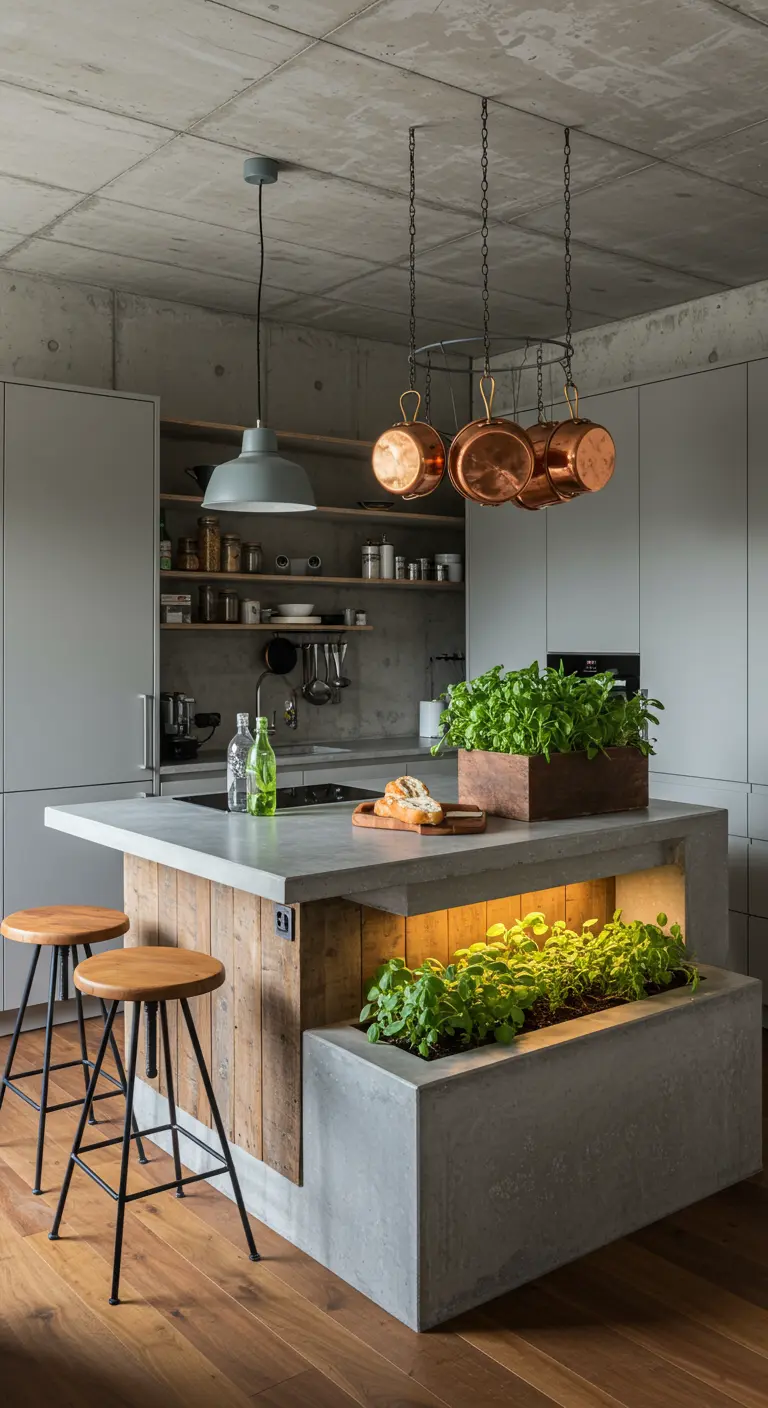
Elevate your kitchen island from a purely functional surface to a dynamic, living hub.
This design cleverly incorporates a two-tiered herb garden directly into the structure, lit from within to highlight the greenery.
The warm, reclaimed wood inset provides a beautiful, rustic contrast to the sleek concrete.
This brings fresh ingredients right where you need them, blending utility and beauty.
26. Create a Purposeful Reading Corner
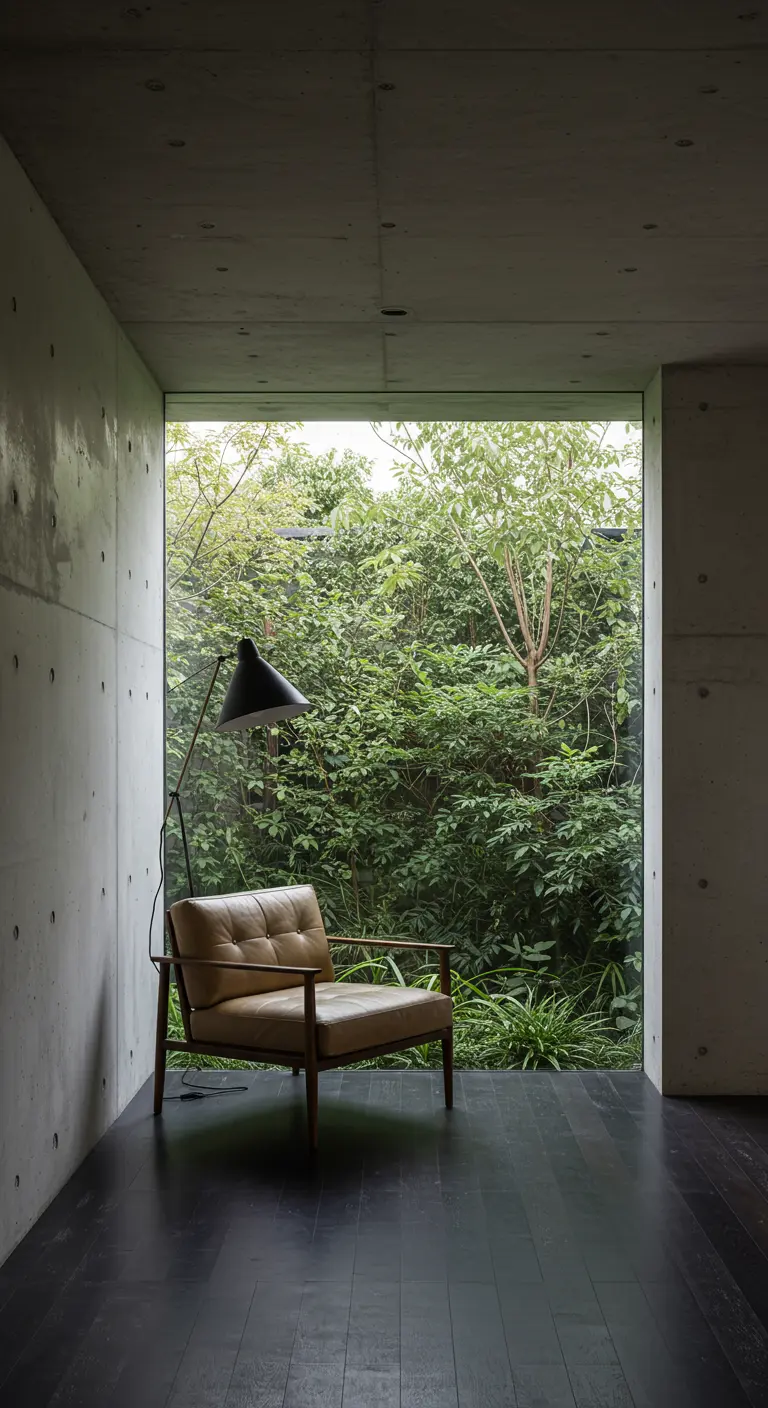
You don’t need a built-in nook to create the perfect retreat.
Position a comfortable, beautifully designed chair and a dedicated reading lamp directly in front of a floor-to-ceiling window.
This simple, deliberate act carves out a specific zone for contemplation and escape.
The key is to frame the view and commit the corner to this single, calming purpose.
27. Designate an Indoor Garden “Room”

Go beyond a few scattered pots and dedicate a significant portion of your floor plan to an indoor garden.
This creates a powerful, grounding connection to nature and can act as a natural, beautiful divider in an open-concept space.
Use a variety of plants, ferns, mosses, and rocks to mimic a real forest floor, providing a constant source of tranquility and defining the entire home’s character.
This gives even compact rooms garden vibes.
28. Unify a Wall with a Continuous Built-in
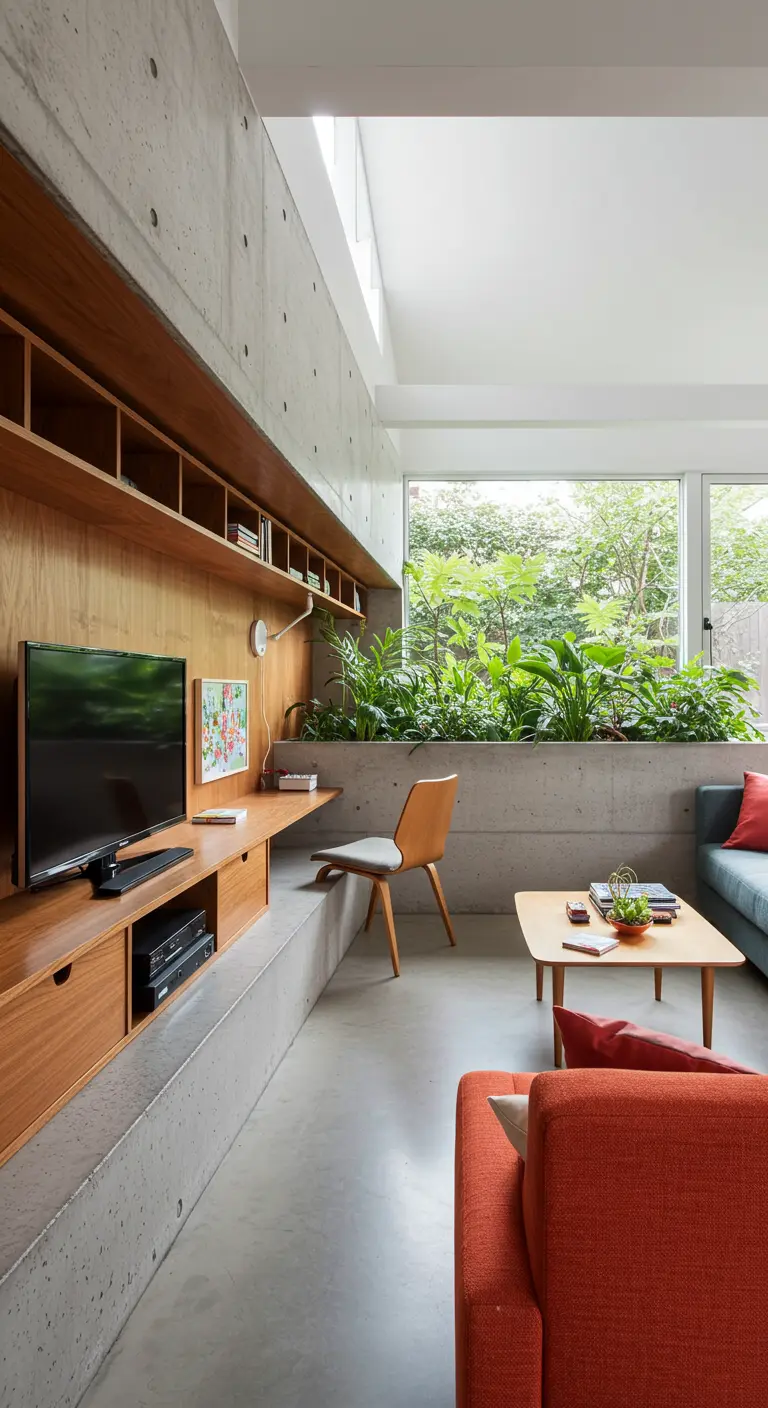
In a long room, create cohesion and maximize function with a low, continuous built-in unit.
This structure seamlessly combines a media console, desk, and planter shelf into one architectural element.
The concrete base provides a solid anchor, while the warm wood top connects the different zones.
This strategy declutters the floor and creates a clean line that makes the multipurpose room feel organized and spacious.
29. Create a Shower That Feels Like a Rainforest
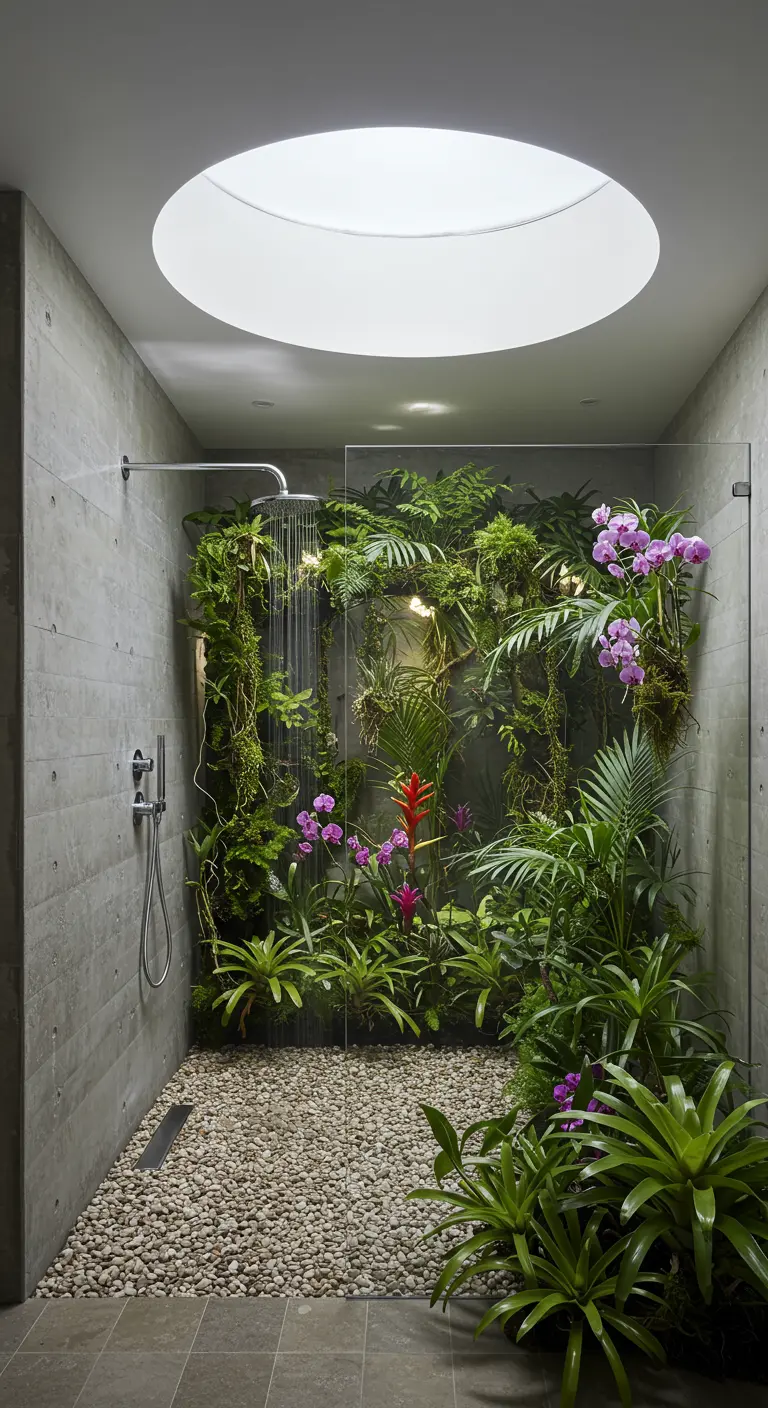
Transform your daily routine into an immersive, spa-like experience.
A circular skylight above mimics the sun breaking through a forest canopy, illuminating a living wall of tropical plants.
Humidity-loving orchids, bromeliads, and ferns will thrive in this environment, turning your shower into a private greenhouse.
The pebble floor completes the sensory experience, creating the ultimate luxury spa bathroom at home.
30. Layer Your Lighting for Nighttime Drama
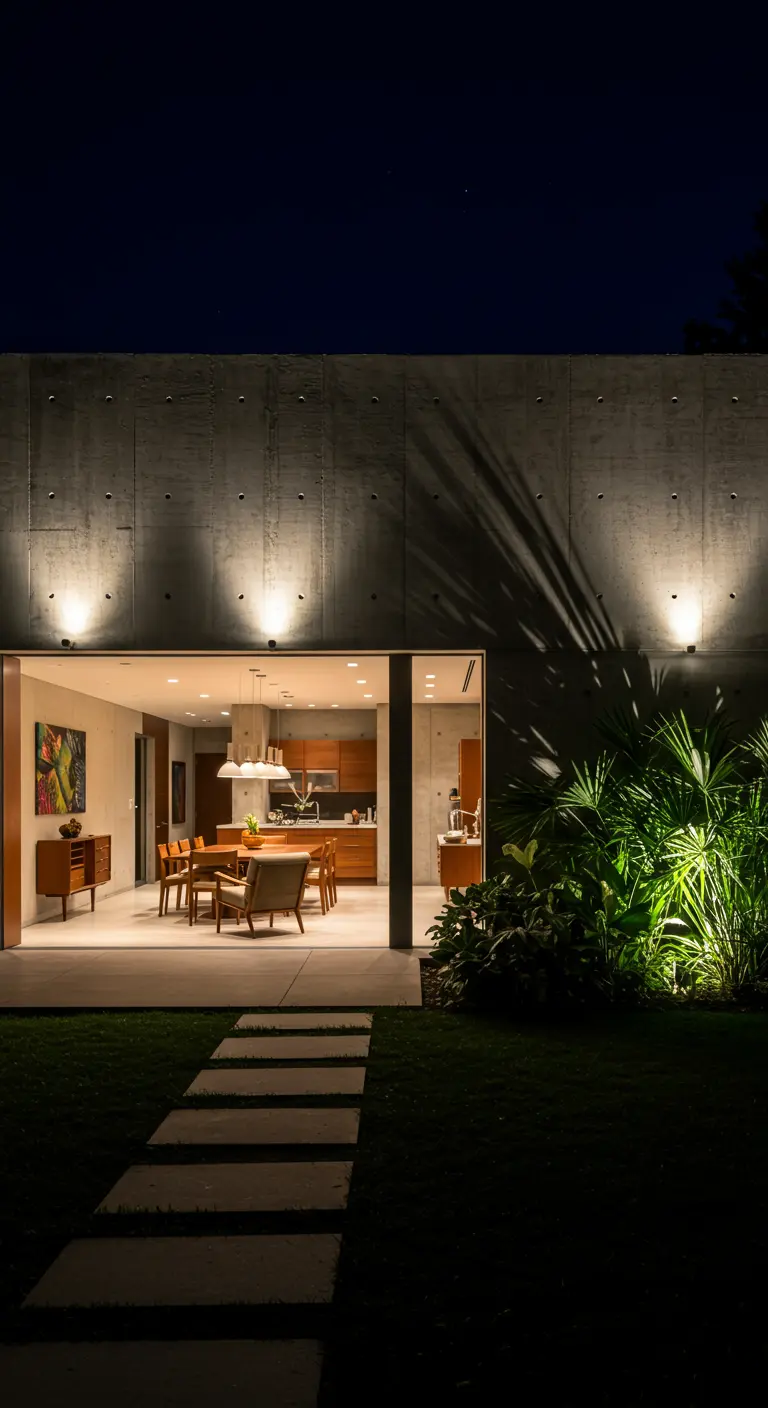
Create a stunning exterior presence by thinking about light in three distinct layers.
First, the warm, ambient glow from inside the house acts as an inviting beacon.
Second, uplights on the exterior walls highlight texture and architectural form.
Third, focused spotlights within the garden pick out specific plants, creating depth and a touch of mystery.
This thoughtful combination turns your home into a beautiful composition of light and shadow after dark.
